LUFS Meter Manual
version 2.1.2
Table of contents
- Introduction
- Definitions and compliance
- Installation
- Usage
- Interface - Overview
- Interface - Built-in help
- Interface - Move and scale with the mouse
- Interface - Mouse position info
- Measure the loudness of a single track
- Measure the loudness of an entire multitrack project
- Adjust the loudness
- Measure and adjust as fast as possible in a DAW (offline processing)
- Synchronisation
- Create a faders up mix
- Judge effects effectively
- Compare your work with reference tracks
- Comply with a high loudness target
- Loudness compliance for broadcast
- Daisychained LUFS Meters
- Multiple sync groups
- Settings and presets
- Appendix
- Accuracy of the LUFS Meter
- Files
- Troubleshooting
- Uninstall
- Acknowledgements
- Copyright notice
- PDF manual
Introduction
About the LUFS Meter
The LUFS Meter is a software audio plug-in that measures the integrated loudness (program loudness), the short-term, the momentary loudness and the true peak. The automatic gain adjustment of the plug-in simplifies the process of creating loudness compliant material. The LUFS Meter is compliant with a multitude of international loudness specifications and recommendations.
Because the integrated loudness is close to the human perception of loudness, the automatic gain adjustment of the LUFS Meter makes it easy to match the loudness of multiple songs for an album, a movie or a show. It also enables you to compare your work with reference tracks at the same loudness. And to objectively judge if a given audio effect really yields an improvement.
On top of that, the LUFS Meter contains a unique synchronisation mechanism to make each track of a project equally loud - a so called 'faders up mix'. A perfect starting point for the creative mixing process.
Open source at heart
The loudness measurement algorithm used in the LUFS Meter has been made available for free by Klangfreund (with a permissive MIT license). So a curious user can take a look at the inner workings of the LUFS Meter. Or build his own software on top of that.
Reviews
Reviews can be of great help understanding a product better. Here are a few LUFS Meter reviews.
- Sound on Sound : Klangfreund LUFS Meter - Loudness Metering & Matching Plug-in. By Dennis J Wilkins
- audiofanzine.com : Klangfreund LUFS Meter Review - May the Volume Be With You. By Nantho
- justmastering.com : Review of Klangfreund's LUFS Meter Plug-in. By Rob Stewart
- fcpxpert.net : CALM Down! – Legalize Your Mix. By Charlie Austin
Definitions and compliance
Loudness
In contrast to earlier approaches, modern loudness measurement is quite close to the human perception of loudness.
Loudness measures
| I | Integrated loudness | The actual loudness, measured since the last reset. Also called the program loudness. |
| S | Short-term loudness | The loudness of the past 3 seconds. |
| M | Momentary loudness | The loudness of the past 400 milliseconds. |
| LRA | Loudness range | Quantifies the variation of the short-term loudness since the last reset. Or described differently: A big loudness range indicates that there is a big difference between the loudest and the most quiet sections. For the first 60 seconds, the LRA value in the LUFS Meter is blinking to point out that the loudness range is not considered stable yet. |
LUFS = LKFS = K-weighted loudness units with reference to digital full scale.
The numerical loudness measurement values are displayed at the bottom right of the LUFS Meter. Above the numbers, bars visualize the measurements graphically. On the left side, graphs show the measurement values over time.
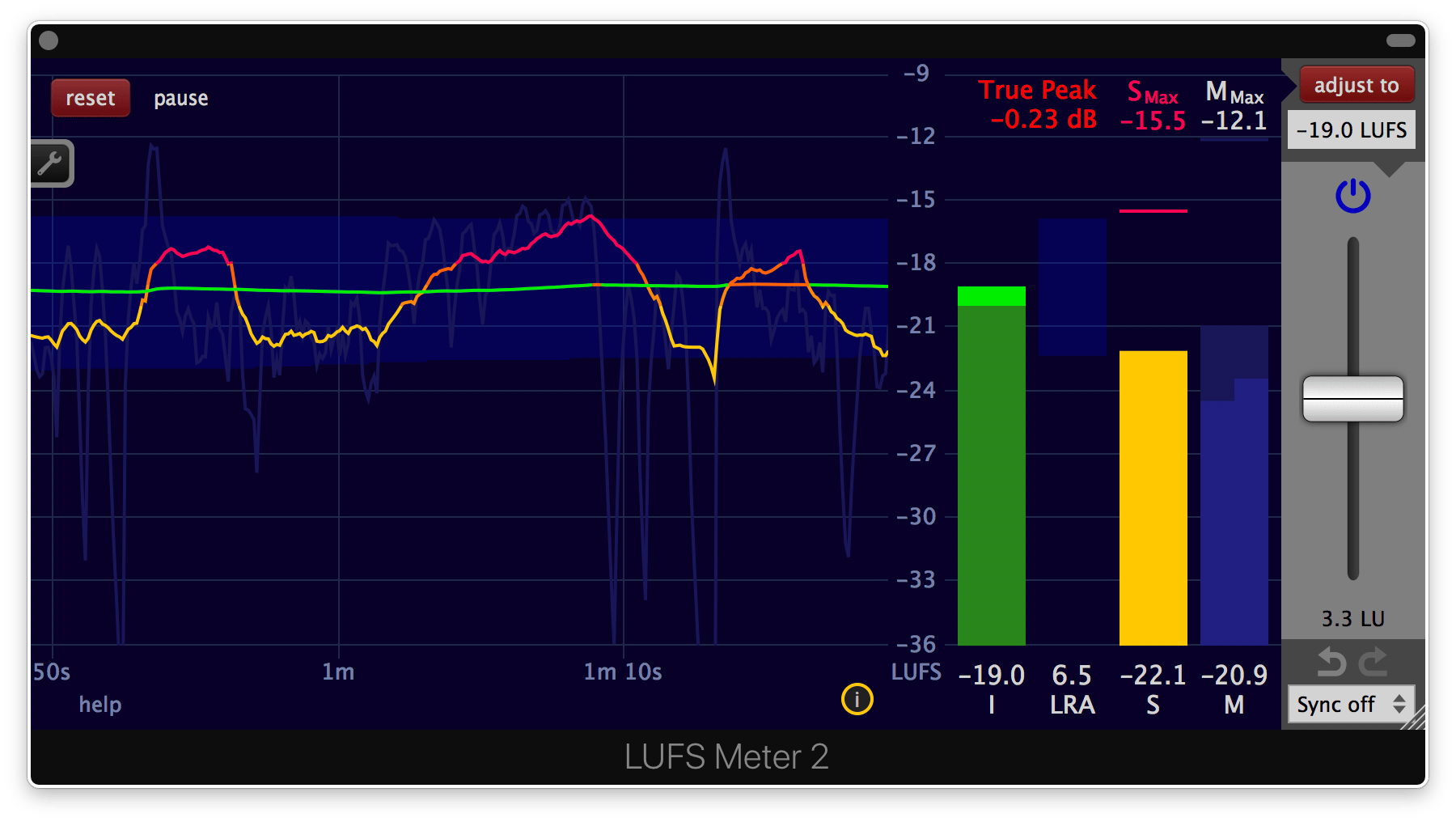
The LUFS Meter has been built according to the specifications ITU-R BS.1770 revision 1 to 4, EBU R128, EBU R128 s1 v2.0, EBU Tech 3341 v3.0 and EBU Tech 3342 v3.0.
Note about LUFS and dB
It is not possible to measure the loudness (According to the specifications of ITU-R BS.1770) with a traditional peak or RMS measurement device. A loudness meter like the LUFS Meter or the Multimeter is needed for this task.
Nevertheless, there is a certain connection. A change in volume by x dB in your DAW will result in a change of exactly x LU of the integrated loudness in the LUFS Meter.
Example: A piece gets measured with the LUFS Meter and it has an integrated loudness of -26 LUFS. Now a gain plug-in is inserted in front of the LUFS Meter and it is set to +3 dB. For a second time the loudness gets measured with the LUFS Meter. This time the integrated loudness is -23 LUFS (-26 LUFS + 3 LU).
True peak
| True-peak | The maximum (positive or negative) value of a signal in the continuous time domain. |
| True peak | The estimate of the true-peak of a discrete time signal. |
The definition of 'true-peak' - as stated above - is provided in ITU-R BS.1770-4, Annex 2. In the same document it is suggested to estimate the true-peak of a band-limited signal given in the discrete time domain with a sample rate of 48kHz by applying 4 times oversampling and to take the absolute maximum of the oversampled signal.
Many implementations and documents use the same term 'true-peak' for the 'estimate of the true-peak'. To clearly distinguish between these two different things, the estimate of the true-peak is called 'true peak' (without the '-' between 'true' and 'peak') by Klangfreund. This is not a generally approved terminology.



In the LUFS Meter, the oversampling factor for the true peak calculation can be set manually or automatically. With up to 16 times oversampling.
The maximum true peak deviation - the maximal possible difference between the true-peak and the estimate of the true-peak - is provided in the Misc settings.

Compliance with international loudness specifications
The LUFS Meter is compliant with international loudness specifications and recommendations:
- AES TD1004.1.15-10 (streaming)
- AGCOM 219/09/CSP (Italy)
- ARIB TR-B32 (Japan)
- ATSC A/85 / PRSS / CALM Act (US)
- EBU R 128 (Europe)
- EBU R 128 s1 (short content, v2.0 Jan 2016)
- EBU Tech Doc 3341 (EBU Mode, v3.0 Jan 2016)
- EBU Tech Doc 3342 (Loudness range, v3.0 Jan 2016)
- ITU-R BS.1770 revisions 1 to 4 (Oct 2015)
- OP-59 (Australia)
Presets for these standards and recommendations are included. So are presets for helping to produce and deliver for popular streaming platforms:
- Apple Music
- Netflix
- Spotify
- Youtube
Further reading
The EBU Tech 3343 document written by Florian Camerer explains what loudness measurement according to EBU R128 is and provides practical guidelines for different applications. Loudness measurement has also been a cover story in Sound On Sound.
If you prefer technical papers, read Annex 1 (page 2 to 7) of ITU-R BS.1770-4 as well as the EBU – TECH 3341. This note roughly illustrates how these specifications are implemented in the LUFS Meter. Additional technical documents are available at ebu.ch.
Installation
System requirements
- macOS 10.7 or newer
- Windows XP or newer
- Linux Experimental
Compiled under Ubuntu 16.04 with as few dependencies as possible to make it work on as many distributions as possible. Use the demo version to see if your flavour of Linux is supported.
The LUFS Meter is an audio plug-in and requires a host application that supports one of the plug-in formats listed below.
No iLok required.
Supported plug-in formats
- macOS: AAX and AAX Audio Suite (Pro Tools 10.3.5 or later), Audio Unit, VST2 and VST3
- Windows: AAX and AAX Audio Suite (Pro Tools 10.3.5 or later), VST2 and VST3
- Linux: VST2
32 and 64 bit support for all plug-in formats.
LUFS Meter demo
A demo version of the LUFS Meter is available for free at klangfreund.com. No personal data needs to be provided to get it. The demo has two limitations: The measurement time is limited to one minute and it is not allowed to use it for any commercial purpose. Otherwise it provides all the features of the full LUFS Meter. It can be switched between the discounted LUFS Meter demo and the full LUFS Meter demo by clicking the yellow demo banner at the bottom.

Purchasing the LUFS Meter
The LUFS Meter can be purchased at klangfreund.com.
The Klangfreund store uses a secure connection and encryption to protect your personal information. Sensitive credit card data is furthermore directly handled by the payment processors Stripe and Braintree (by PayPal), fullfilling the highest possible PCI DSS level 1 compliance.
Right after the purchase you are automatically logged in to your newly created account, where you can set a password for your account and download the LUFS Meter installer. If you have previously installed the LUFS Meter demo, replace it with this version of the LUFS Meter by simply download and run the installer. Once installed and launched, use your email address and the account password to unlock the LUFS Meter.
Upgrade from the Discounted LUFS Meter to the full LUFS Meter
- If you own a Discounted LUFS Meter 1.x license for USD 24 + EU VAT you can upgrade to a full LUFS Meter 2.x license for USD 15 + EU VAT.
- If you own a Discounted LUFS Meter 2.x license for USD 19 + EU VAT you can upgrade to a full LUFS Meter 2.x license for USD 20 + EU VAT.
The upgrade price is equal to the price difference of the full LUFS Meter license and the Discounted LUFS Meter license. Your upgrade options are available from your account page.
Upgrade to the Multimeter and LUFS Meter bundle
- If you own a LUFS Meter 1.x license (USD 49 + EU VAT) you are entitled to upgrade to a Multimeter and LUFS Meter bundle license for USD 19 + EU VAT.
- If you own a LUFS Meter 2.x license (USD 39 + EU VAT) you are entitled to upgrade to a Multimeter and LUFS Meter bundle license for USD 29 + EU VAT.
- If you own a Discounted LUFS Meter 1.x license (USD 24 + EU VAT) you are entitled to upgrade to a Multimeter and LUFS Meter bundle license for USD 44 + EU VAT.
- If you own a Discounted LUFS Meter 2.x license (USD 19 + EU VAT) you are entitled to upgrade to a Multimeter and LUFS Meter bundle license for USD 49 + EU VAT.
- If you own a Multimeter license (USD 59 + EU VAT) you are entitled to upgrade to a Multimeter and LUFS Meter bundle license for USD 9 + EU VAT.
The upgrade price is equal to the price difference between the bundle and the previously owned license. Your upgrade options are available from your account page.
Upgrade to a single Multimeter license
If you own a license for the Discounted LUFS Meter or for the full LUFS Meter you can upgrade it to a Multimeter license by only paying the price difference of the two licenses.
You will loose your LUFS Meter license when you upgrade it to a Multimeter license. You wont be able to use the LUFS Meter in old projects of yours anymore. Therefore it is recommended to upgrade to the Multimeter and LUFS Meter bundle instead.
- If you own a LUFS Meter 1.x license (USD 49 + EU VAT) you are entitled to upgrade to a Multimeter license for USD 10 + EU VAT.
- If you own a LUFS Meter 2.x license (USD 39 + EU VAT) you are entitled to upgrade to a Multimeter license for USD 20 + EU VAT.
- If you own a Discounted LUFS Meter 1.x license (USD 24 + EU VAT) you are entitled to upgrade to a Multimeter license for USD 35 + EU VAT.
- If you own a Discounted LUFS Meter 2.x license (USD 19 + EU VAT) you are entitled to upgrade to a Multimeter license for USD 40 + EU VAT.
Your upgrade options are available from your account page.
Installation
1. Right after purchasing the LUFS Meter you are redirected to a webpage where you can download the LUFS Meter installer for macOS, Windows and Linux. The installers are also available from your account page as well as from the main LUFS Meter page - if you are logged in. Be aware that the LUFS Meter demo installer is not the same as the LUFS Meter installer.
2a. On macOS, open the downloaded dmg file. It contains the installer (a pkg file) and the pdf manual. Run the installer and follow the instructions.

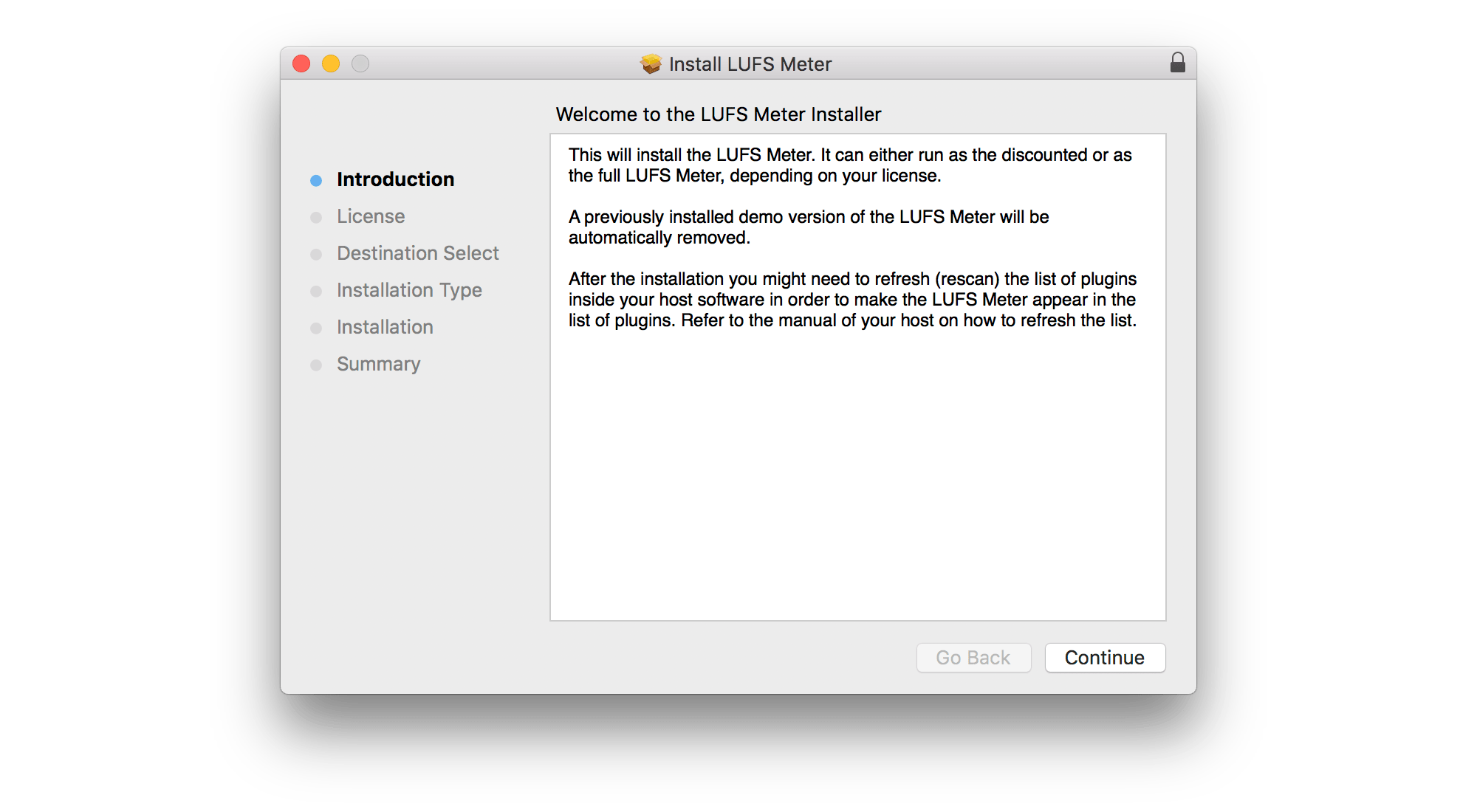

2b. On Windows, run the downloaded installer and follow the instructions.
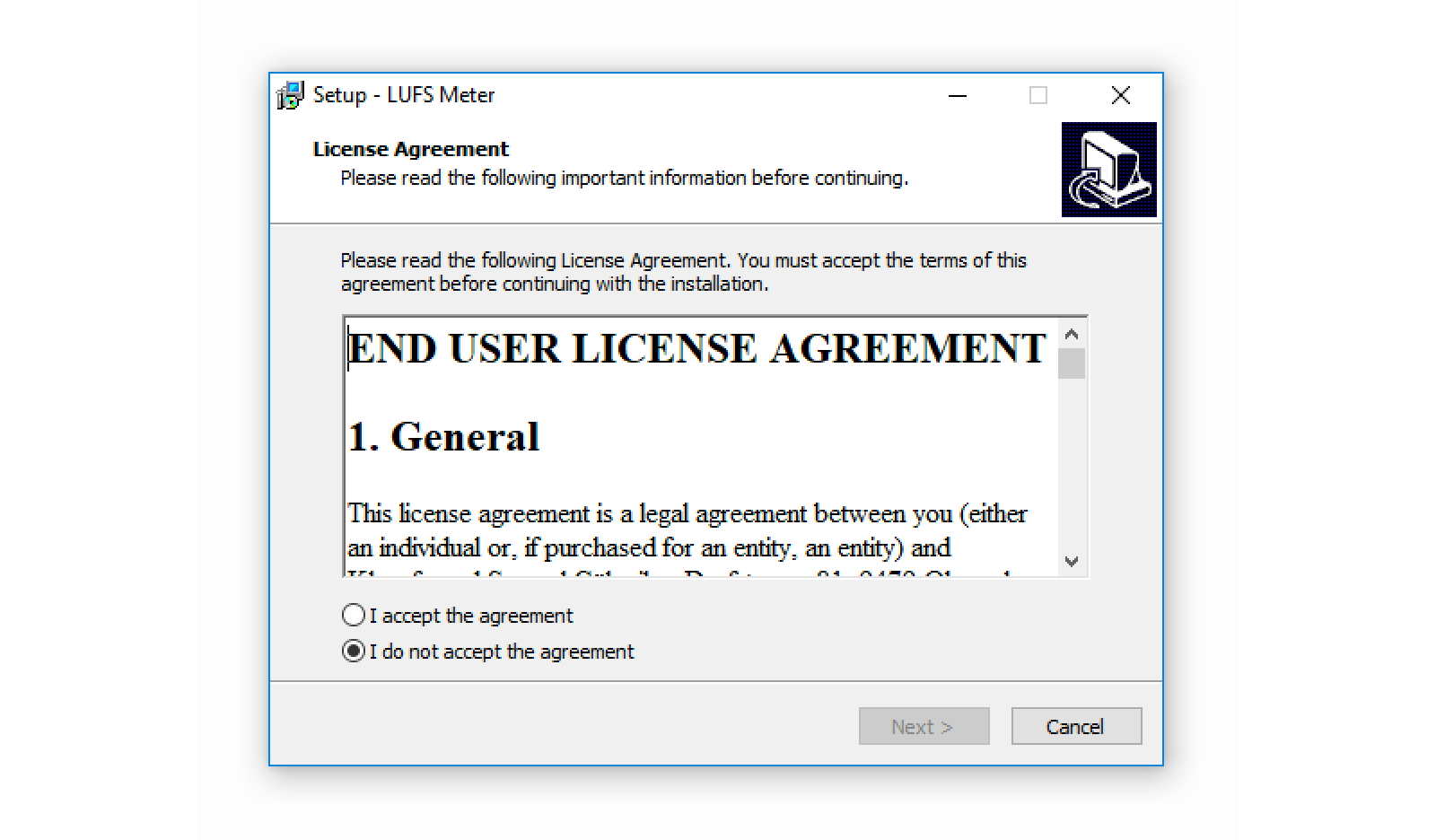
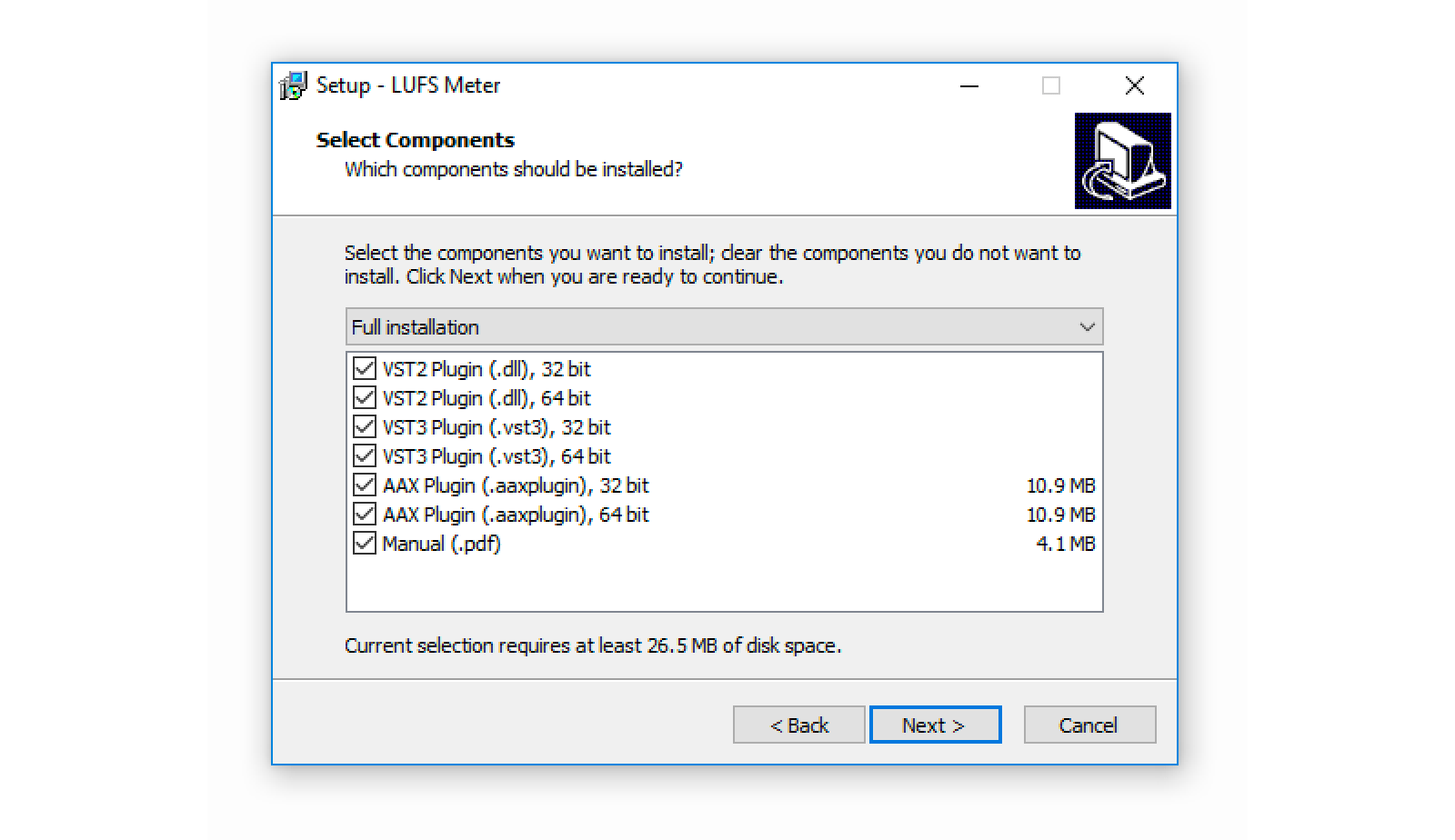
2c. On Linux, extract the downloaded tar.gz archive and move the plug-in file it contains to the appropriate locations - as described in the included README text file.
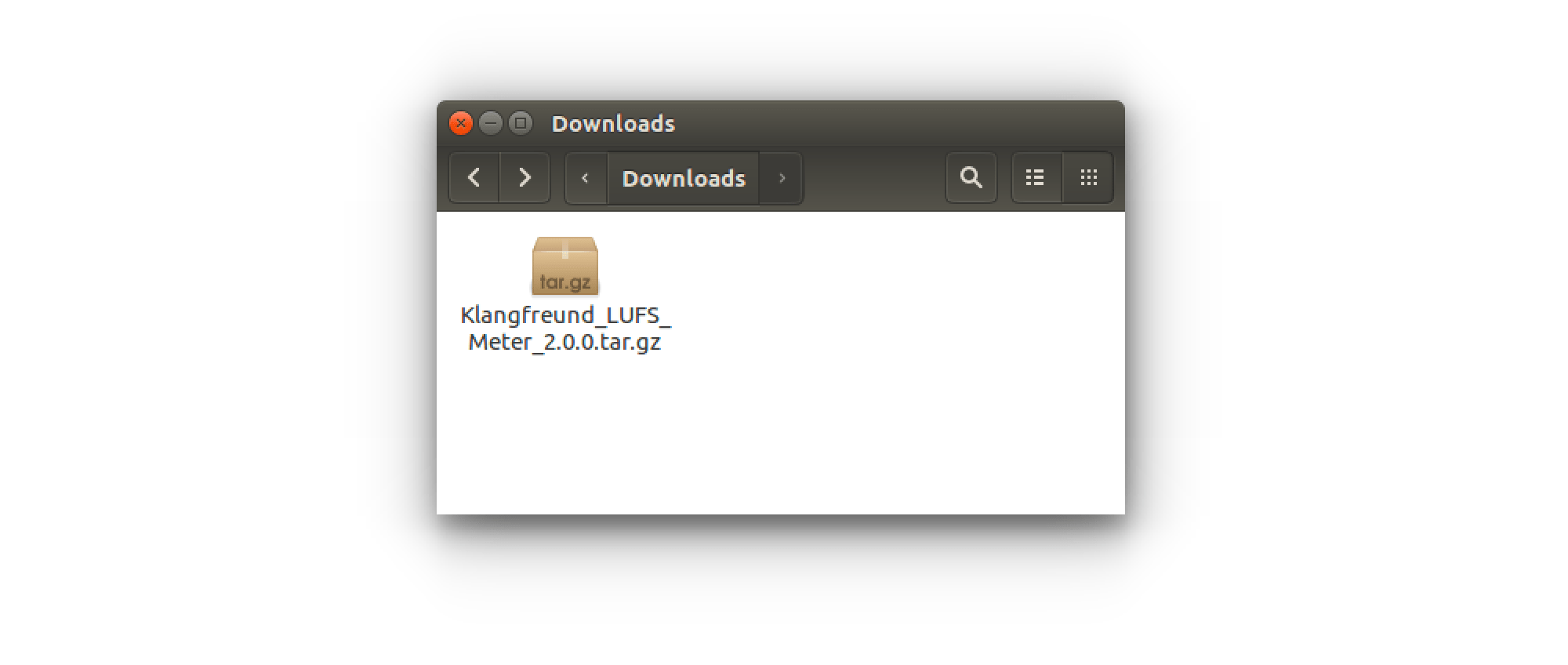
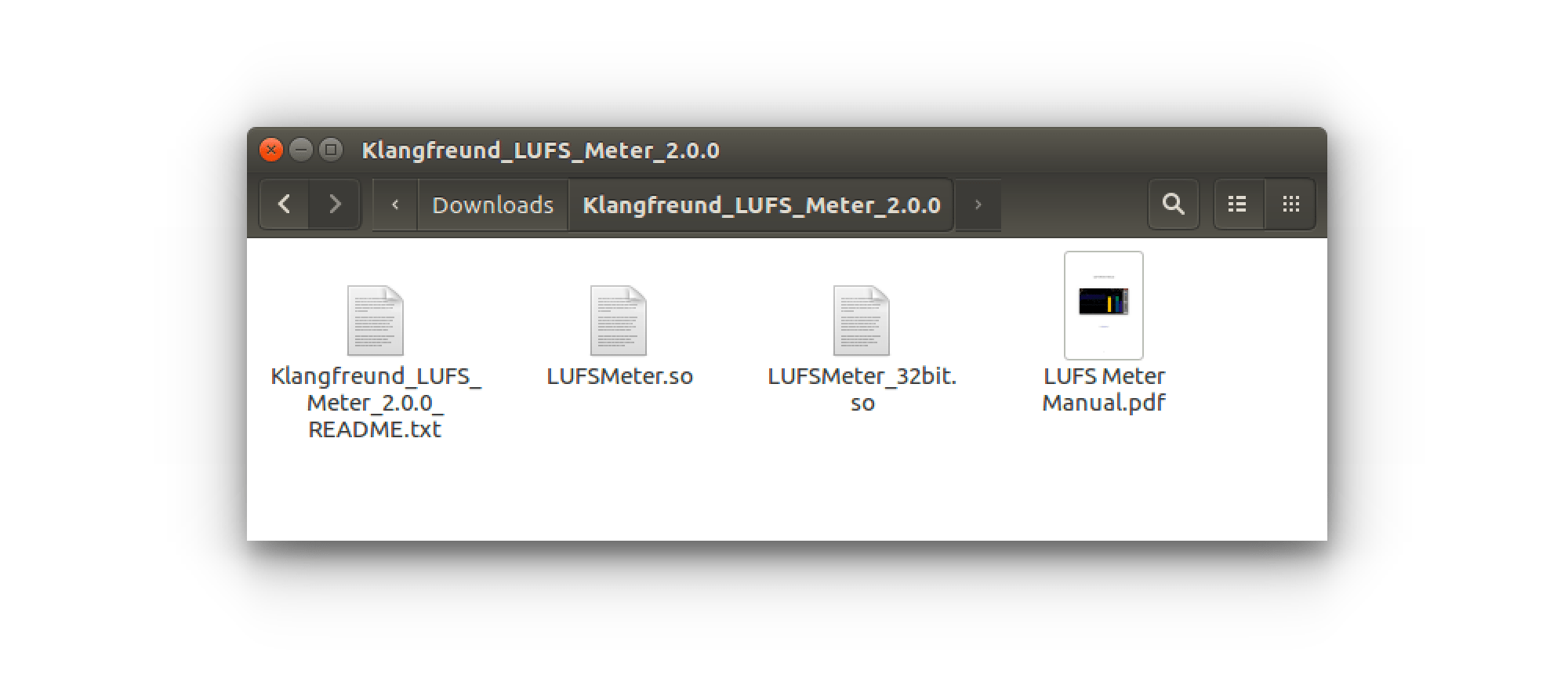
3. Depending on your host (e.g. a digital audio workstation (DAW) or a video editing software supporting audio plug-ins) you might need to scan for new plug-ins before the LUFS Meter appears in its list of plug-ins. Refer to the manual of your host on how to do that.
Upgrade
To upgrade (or to go back to a previous version), run the installer of the LUFS Meter you want to upgrade to (or to go back to). Personal settings and presets won't be altered.
Previous versions of the LUFS Meter can be downloaded from the LUFS Meter all releases page .
Note that the LUFS Meter 1 and the LUFS Meter 2 can be installed and used at the same time. This is due to the fact that the LUFS Meter 2 comes with more automatable parameters and because of that recorded automation data would be misinterpreted if the LUFS Meter 2 would replace the LUFS Meter 1 in a project that was started with LUFS Meters 1. The preset files are compatible, you can copy presets from the LUFS Meter 1 user preset folder to the LUFS Meter 2 preset folder and visa versa.
Unlock
Unlock via the Internet
If your audio computer is running macOS or Windows and if it is connected to the Internet, the unlocking can be done from within the LUFS Meter. Under Linux, use the offline unlock method instead.
Open your host application and add the LUFS Meter plug-in to a track.

1. Click the lock icon.
2. - 3. Enter your email address and the password you set when you've created your user account at klangfreund.com. To make managing your unlock keys at klangfreund.com easier, it is recommended to provide a short description for this computer as well.
4. Click the 'Unlock' button. After a few seconds your LUFS Meter is unlocked.
Unlock on an offline computer
Step 1: On your audio computer, open your host application and add the LUFS Meter plug-in to a track. Click on the 'unlock offline' text in order to see the token for your audio computer. This token is unique for each computer.
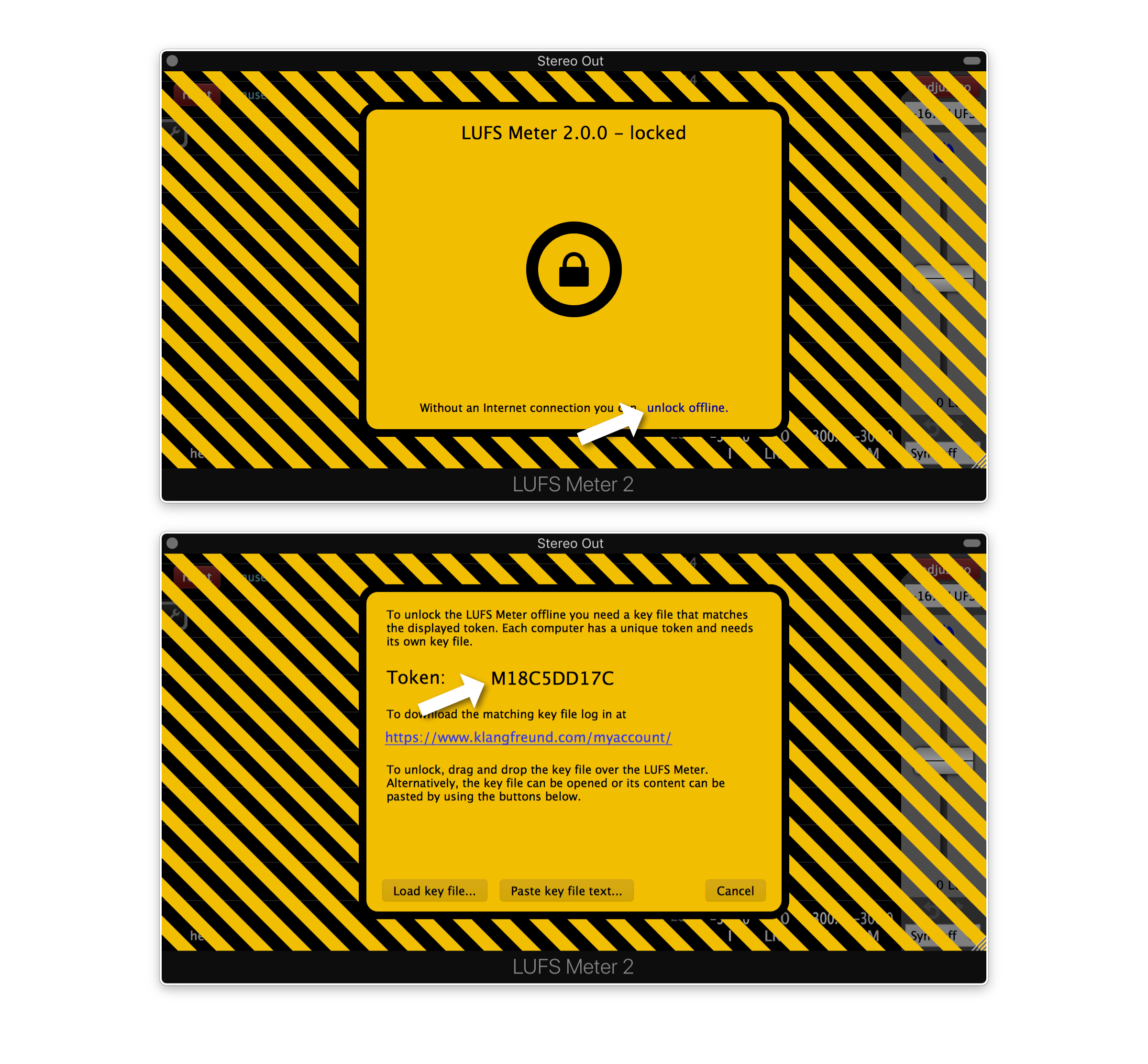
Step 2: To unlock the LUFS Meter a key file is needed which matches this token. To get the key file, use a computer which has Internet access, go to your personal account and follow the illustrated steps.
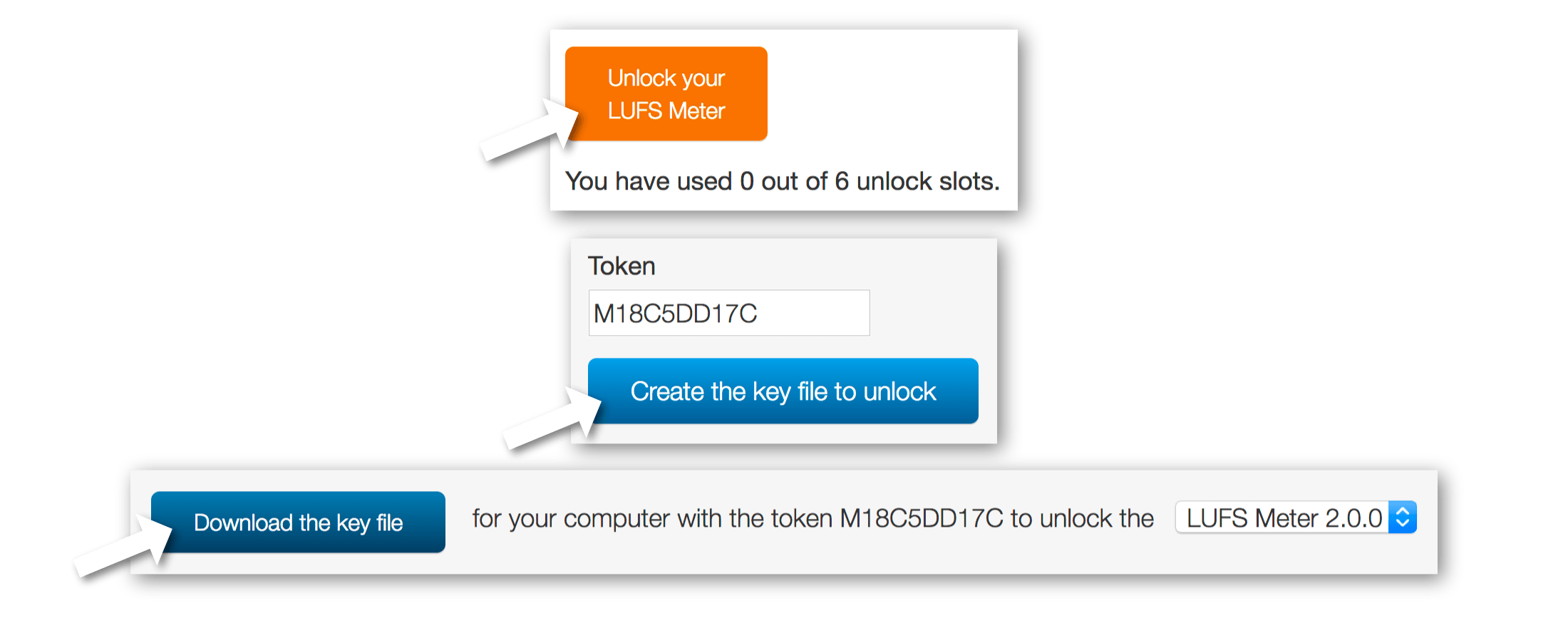
Step 3: Move the key file to your audio computer and drag and drop it over the interface of the LUFS Meter to unlock it.
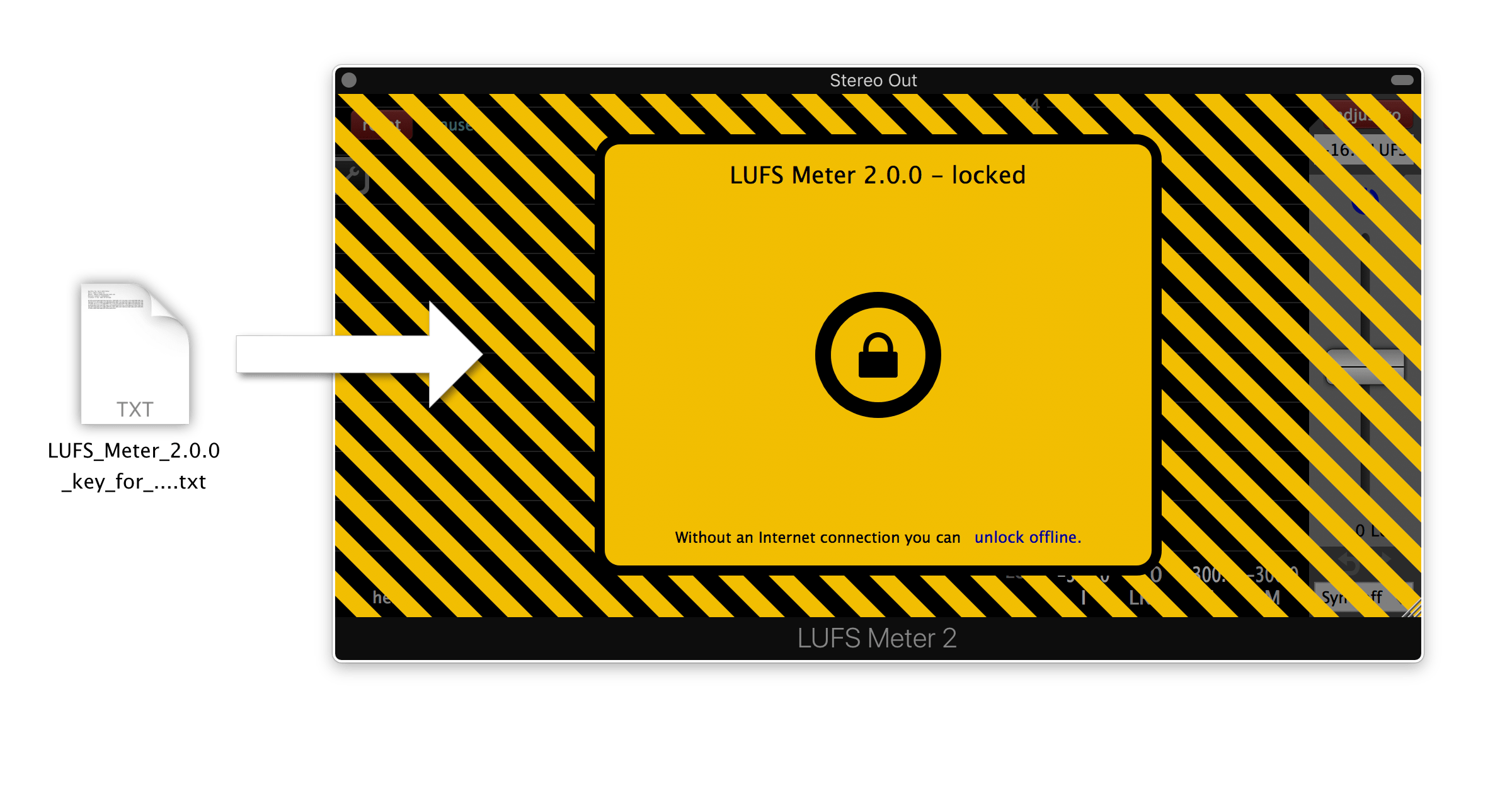
Alternatively you can load the key file via 'unlock offline' -> 'Load key file...' or paste the content of the key file via 'unlock offline' -> 'Paste key file text...'.
Usage
Interface - Overview
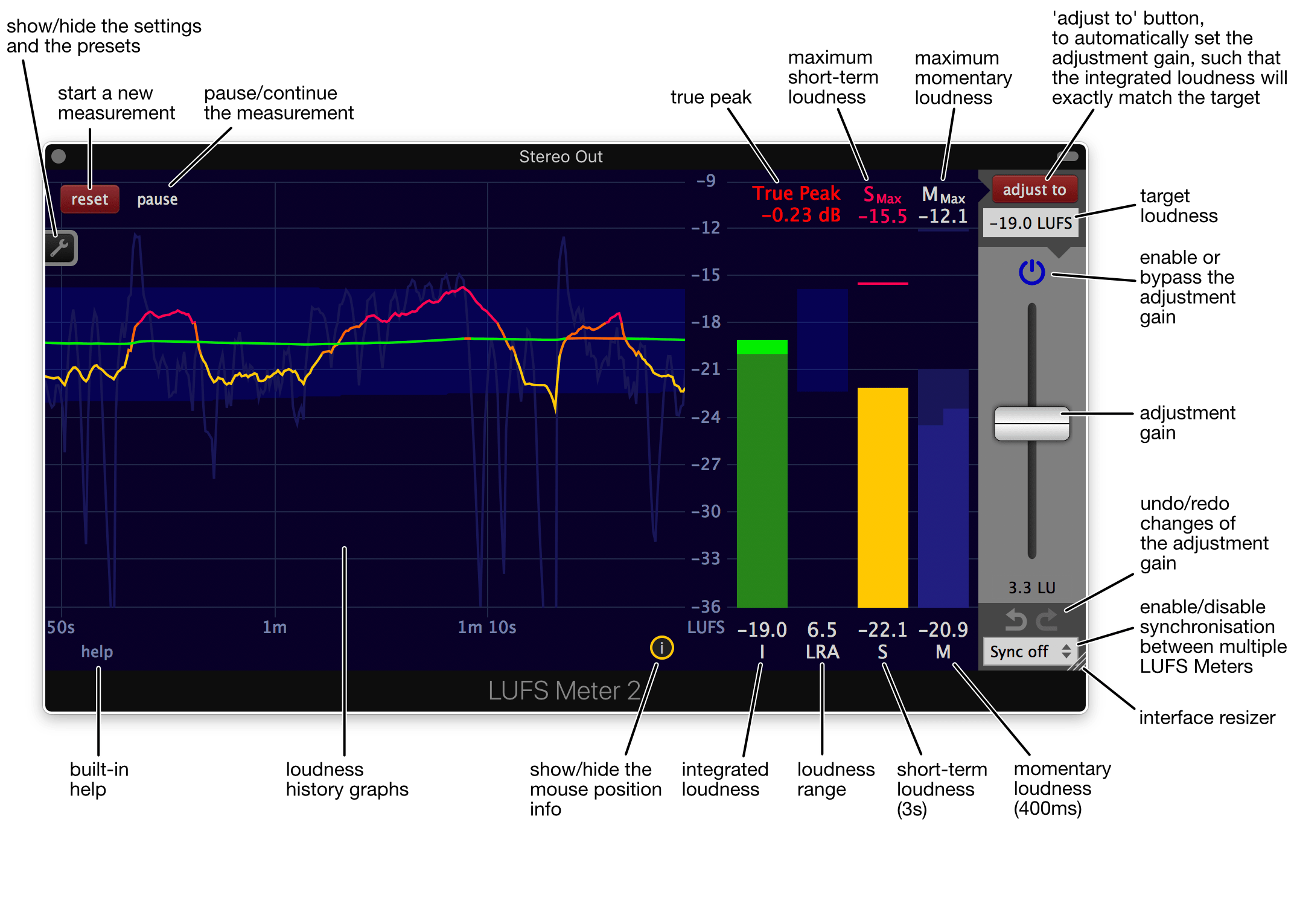
Detailed descriptions of the individual elements are provided by the built-in help.
Interface - Built-in help
The LUFS Meter is equipped with an interactive help system. To enable or disable it, click the help text at the bottom left. If enabled, moving the mouse over an area of the LUFS Meter will display the appropriate description.

Interface - Move and scale with the mouse
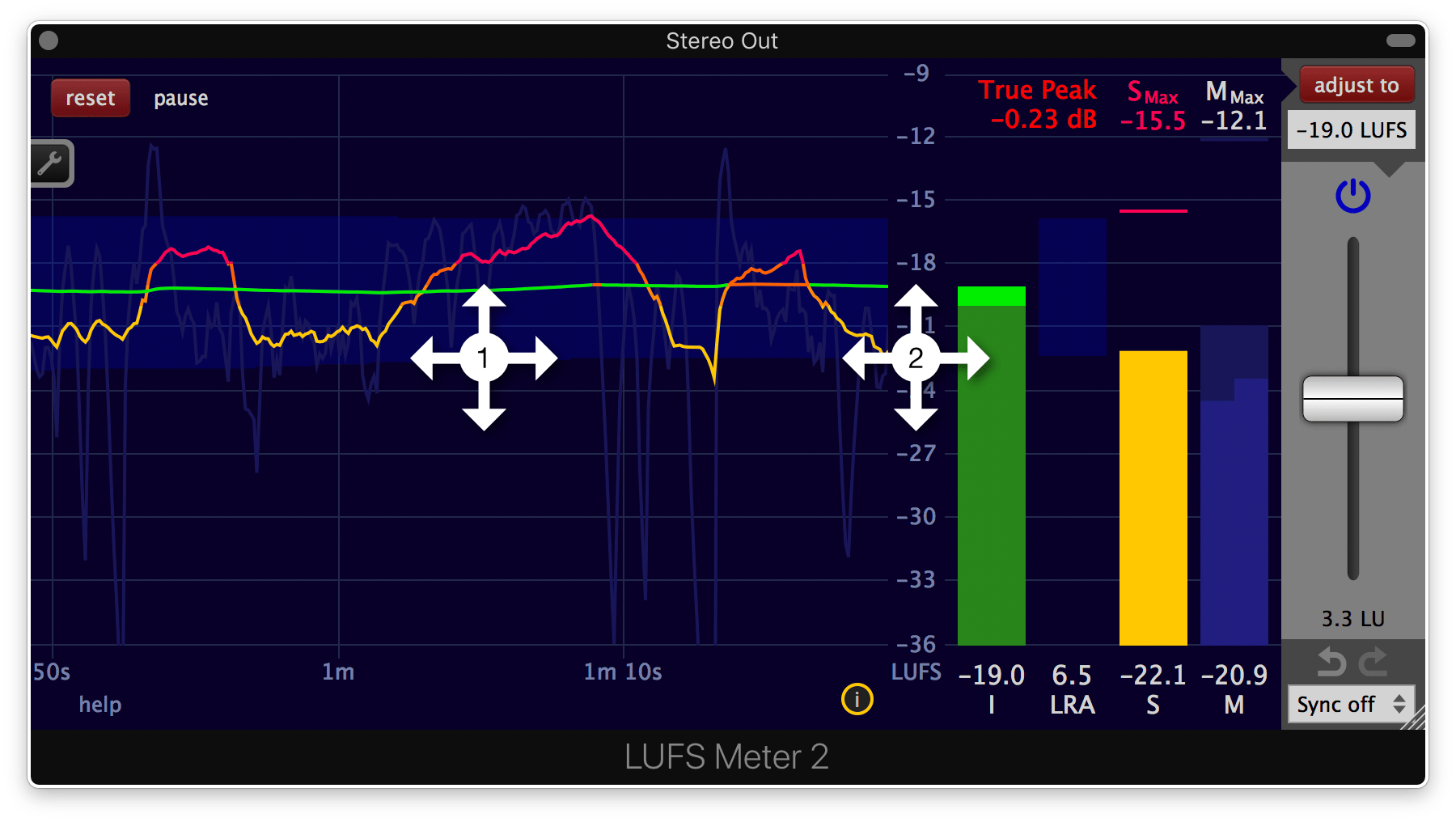
- To zoom in on the history graph, move the mouse cursor over
the area you want to inspect and click and drag the mouse
downwards. Or scroll down with the mouse wheel. To zoom
out, click and drag upwards with the mouse. Or scroll
upwards with the mouse wheel.
To change the visible time interval on the history graph, click and drag horizontally or move the mouse wheel horizontally. A measurement period of up to one week can be revisited on the history graph. One week is only the limit of the visible data in the history graph, a single measurement can be as long as 163 years. - Click and drag vertically on the loudness caption to move
the visible loudness range up and down. The graphs and
bars will move accordingly.
Click and drag horizontally to zoom in or out on the loudness scale.
On the Discounted LUFS Meter, 1. is not available.
Interface - Mouse position info

The mouse position info displays the measurement values corresponding to the time where the mouse cursor is hovering over the history graphs. It is only shown when the mouse cursor is over the area of the history graphs.
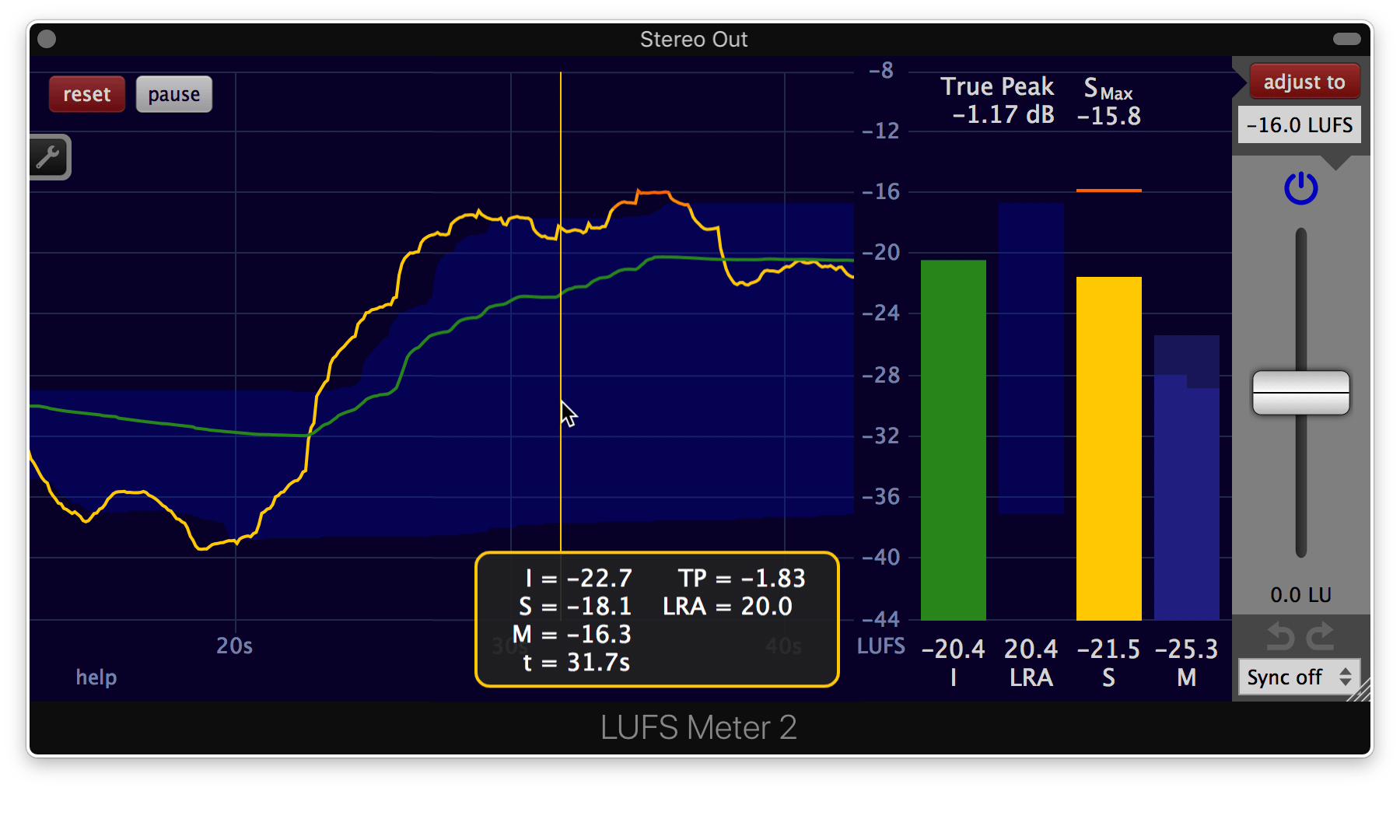
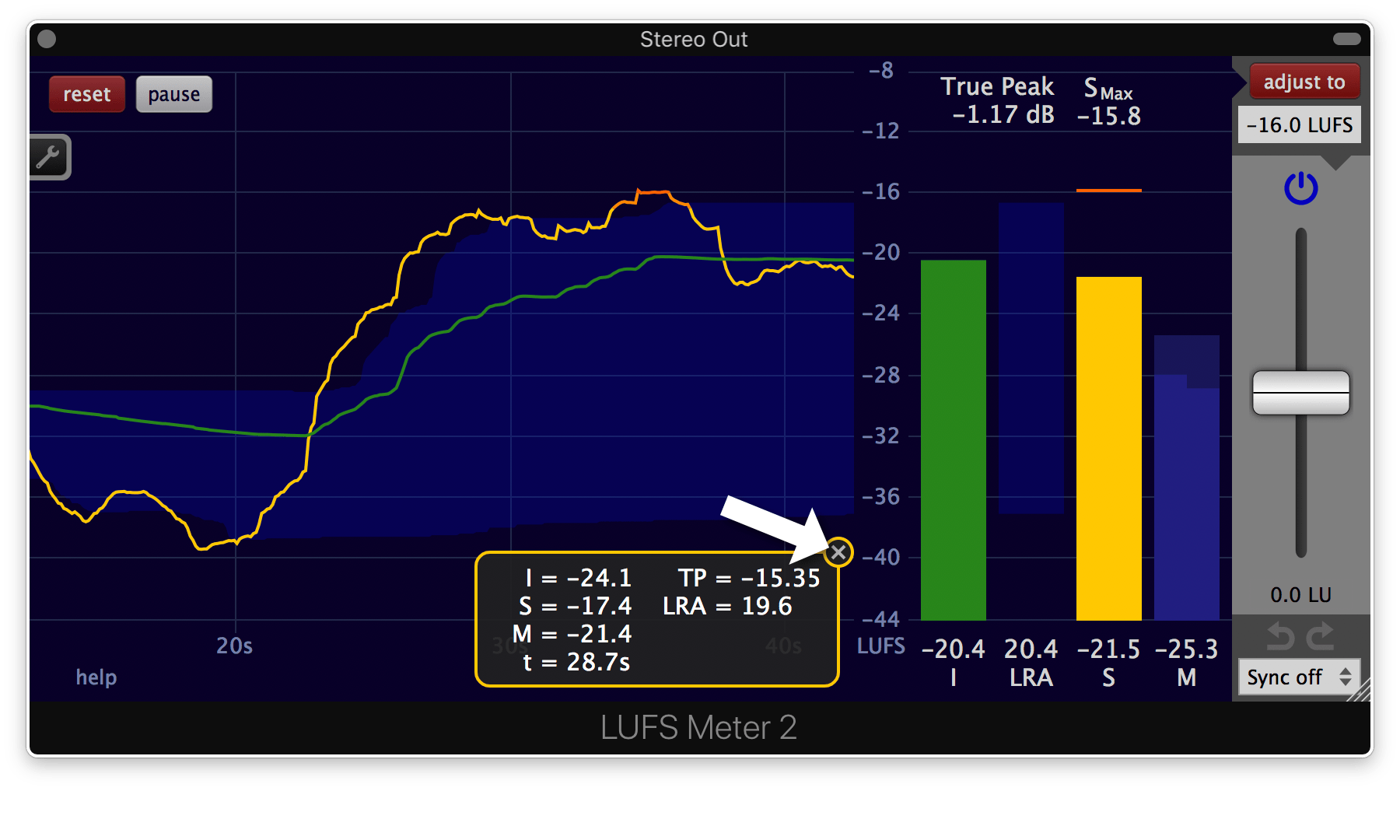
The Discounted LUFS Meter doesn't contain the mouse position info.
Measure the loudness of a single track
Insert the LUFS Meter
The placement of the LUFS Meter in your digital audio workstation (DAW) is crucial. The loudness gets measured at the position the LUFS Meter is inserted. Everything before the LUFS Meter is included in the measurement, everything after the LUFS Meter isn't. Usually you want to include everything and therefore you want to place the LUFS Meter post fader (after the track fader) at the end of your plug-in chain.
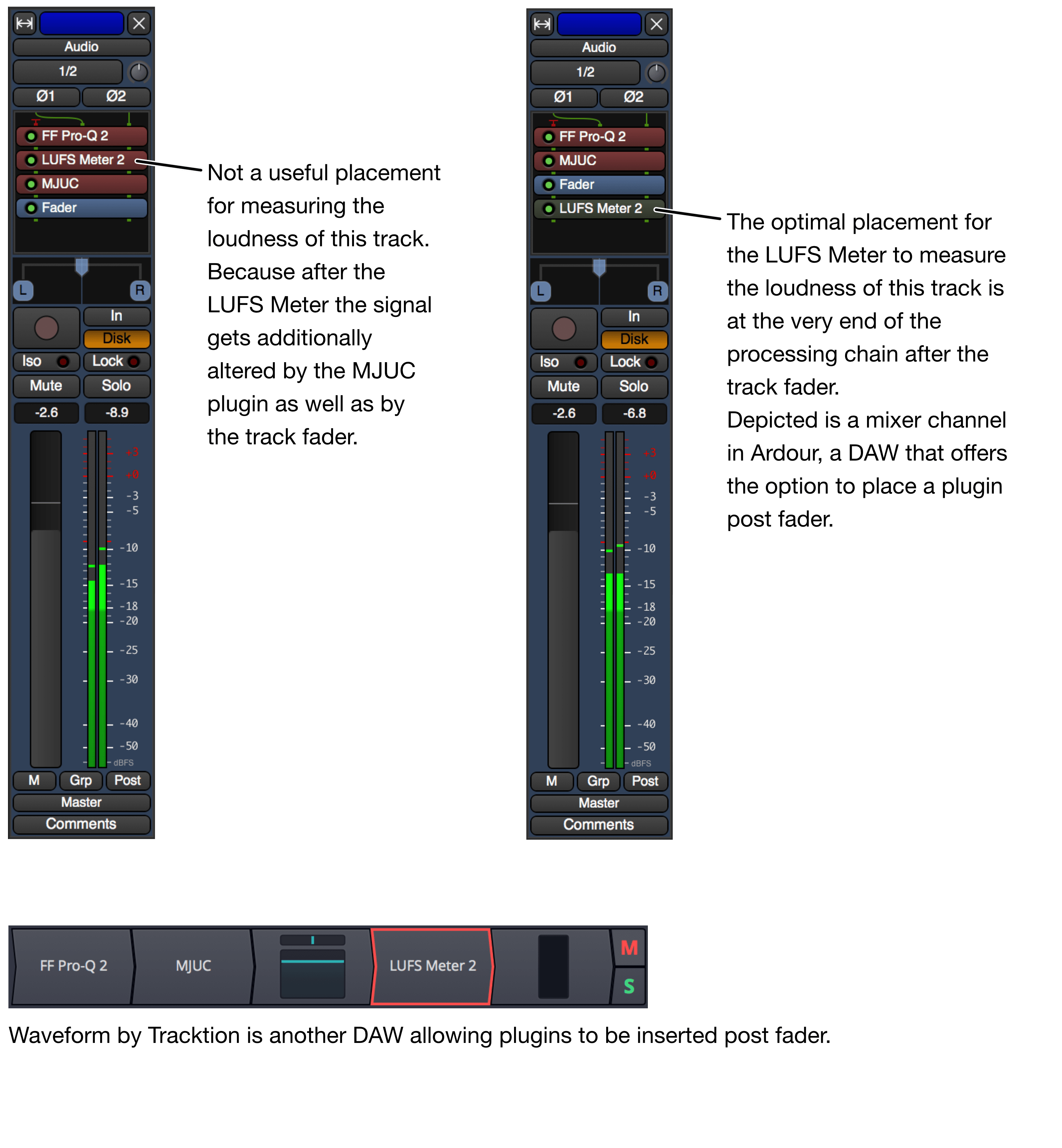
Not every DAW provides the option to insert a plug-in after a track fader. Alternatively, leave the tracks fader permanently at 0 dB(FS) and use a gain utility instead to alter and automate the volume.
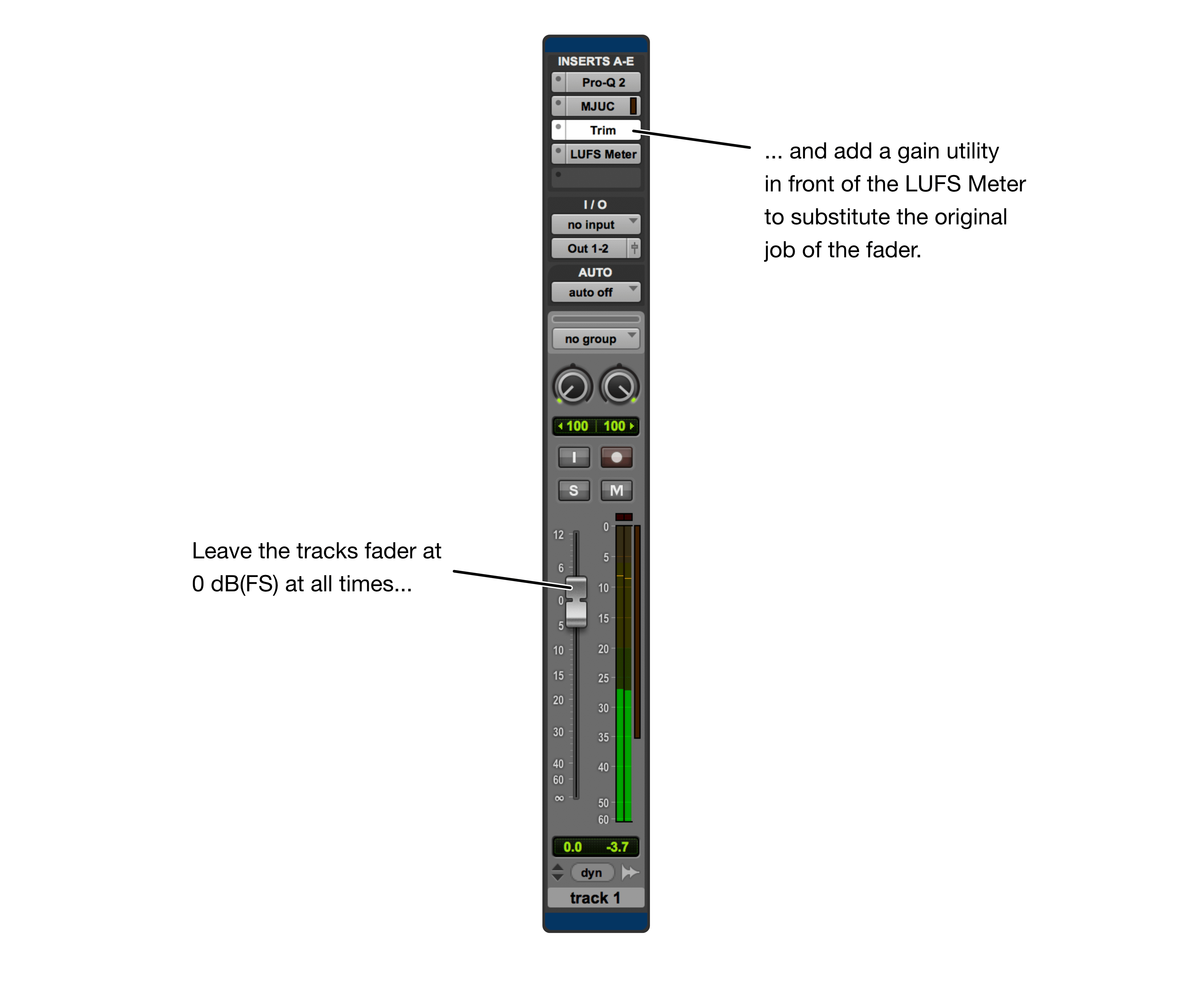
Yet another option for hosts without post fader plug-in support is to route the output of the track to another track/bus where only the LUFS Meter is inserted. It is important that the fader position of that second track/bus stays at 0 dB(FS) without moving.

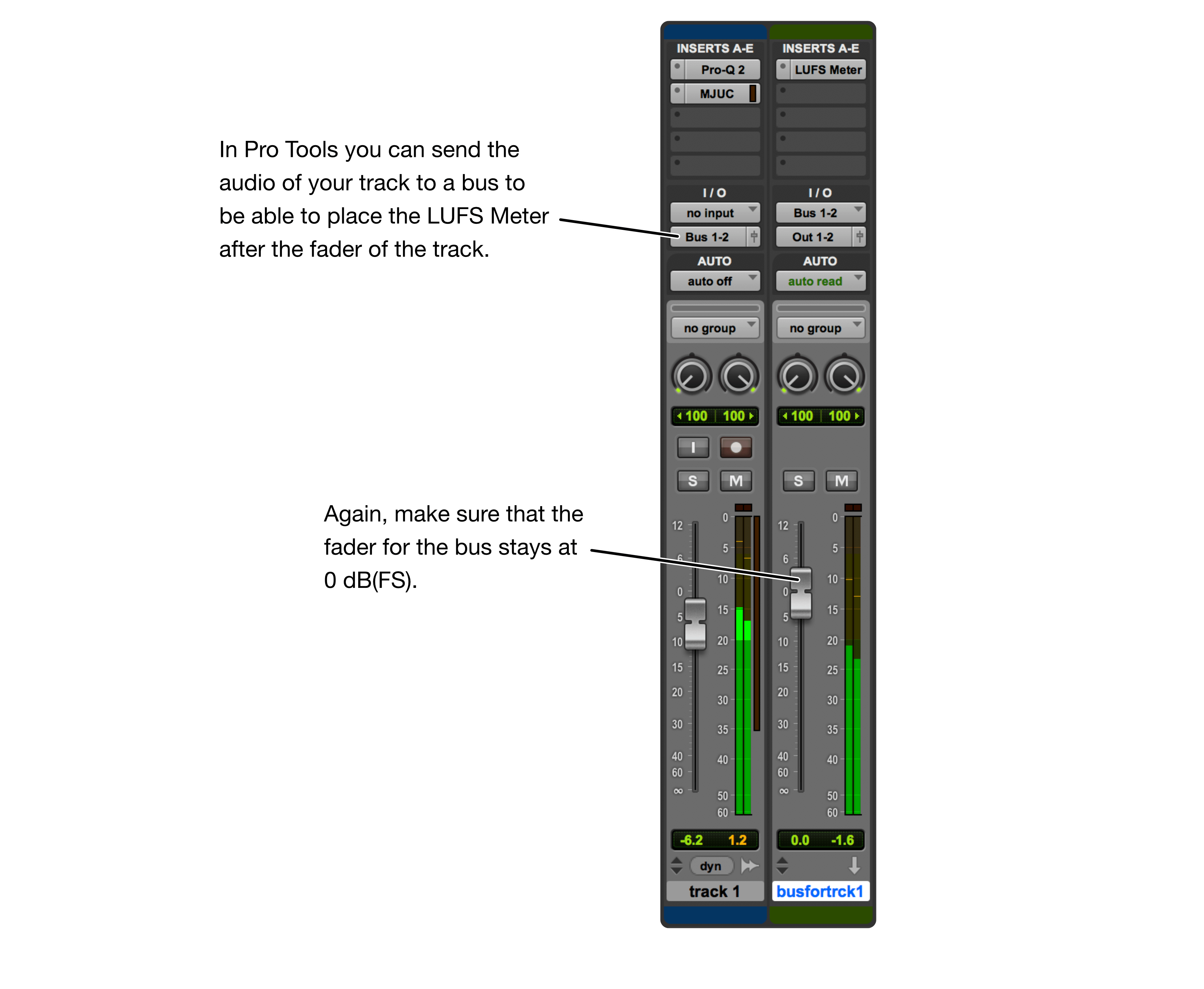
Measure
The whole piece you want to measure needs to be played back through the LUFS Meter in order to be able to determine the loudness.
- Move the playhead of your audio workstation to the beginning.
- Click the reset button of the LUFS Meter.
(Silence is not considered by the loudness measurement, so you don't need to hurry to make the next step.) - Press play in your audio workstation and play back the entire piece.
- When finished, stop the playback.
(Again, the silence that comes after your piece is not taken into account by the measurement, so you don't have to hurry to make the next step.) - Optional: You might want to press the pause button. This will stop the measurement and will decrease the CPU usage of the LUFS Meter.
- Look at the integrated loudness. This is the loudness of your piece.
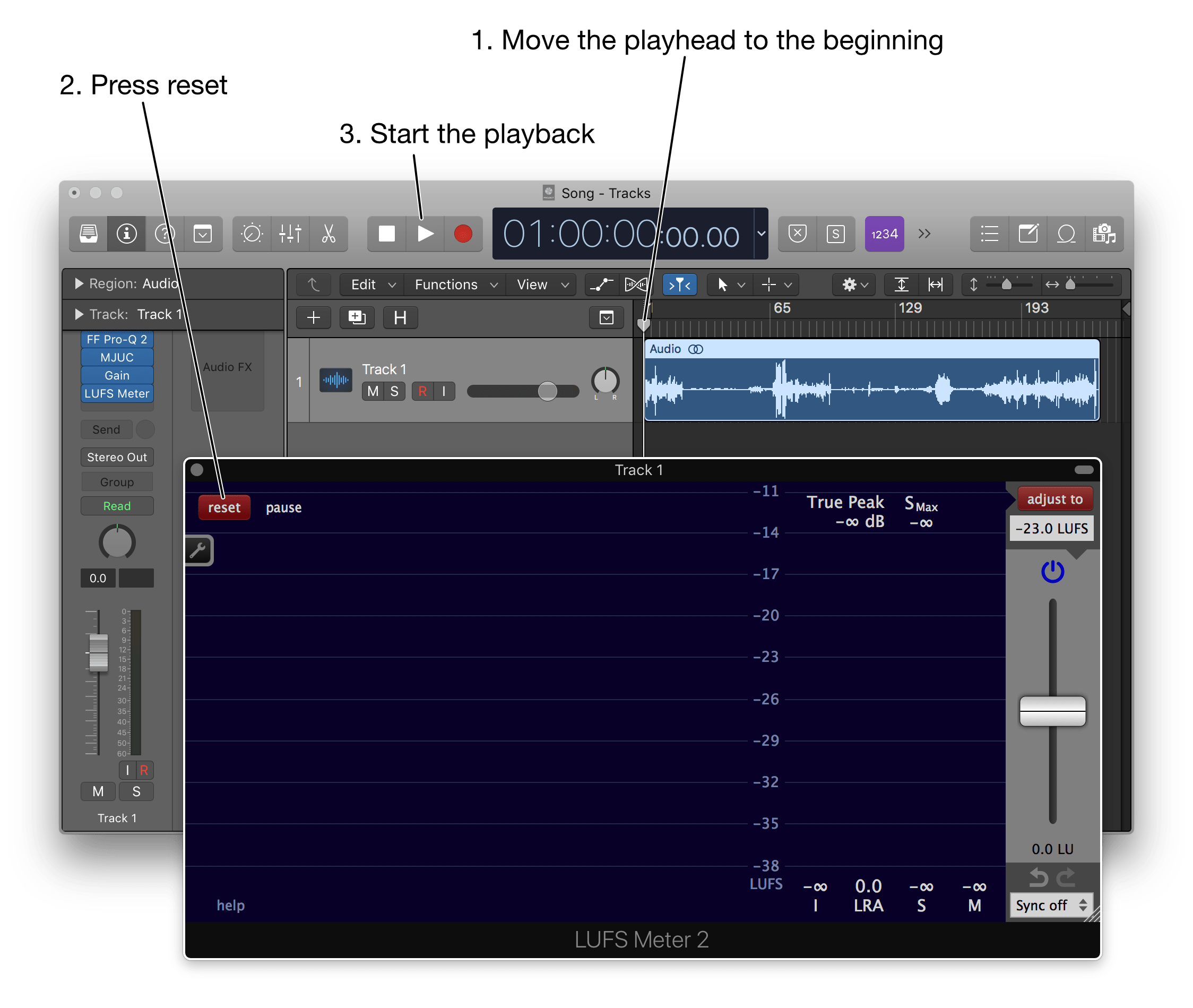
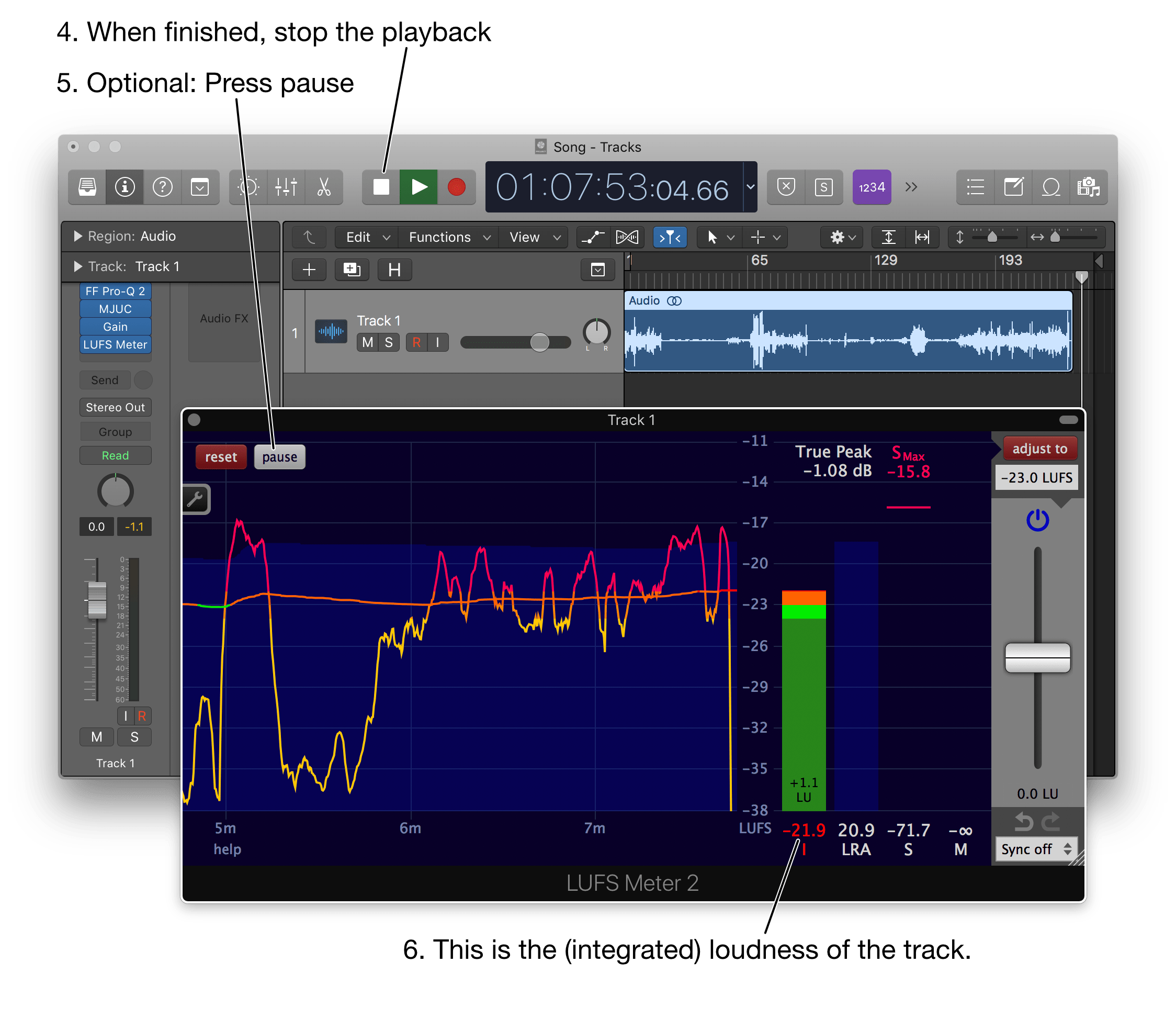
Measure the loudness of an entire multitrack project
Insert the LUFS Meter
If you are interested in the loudness of an entire project, place the LUFS Meter at the very end of the audio signal path.
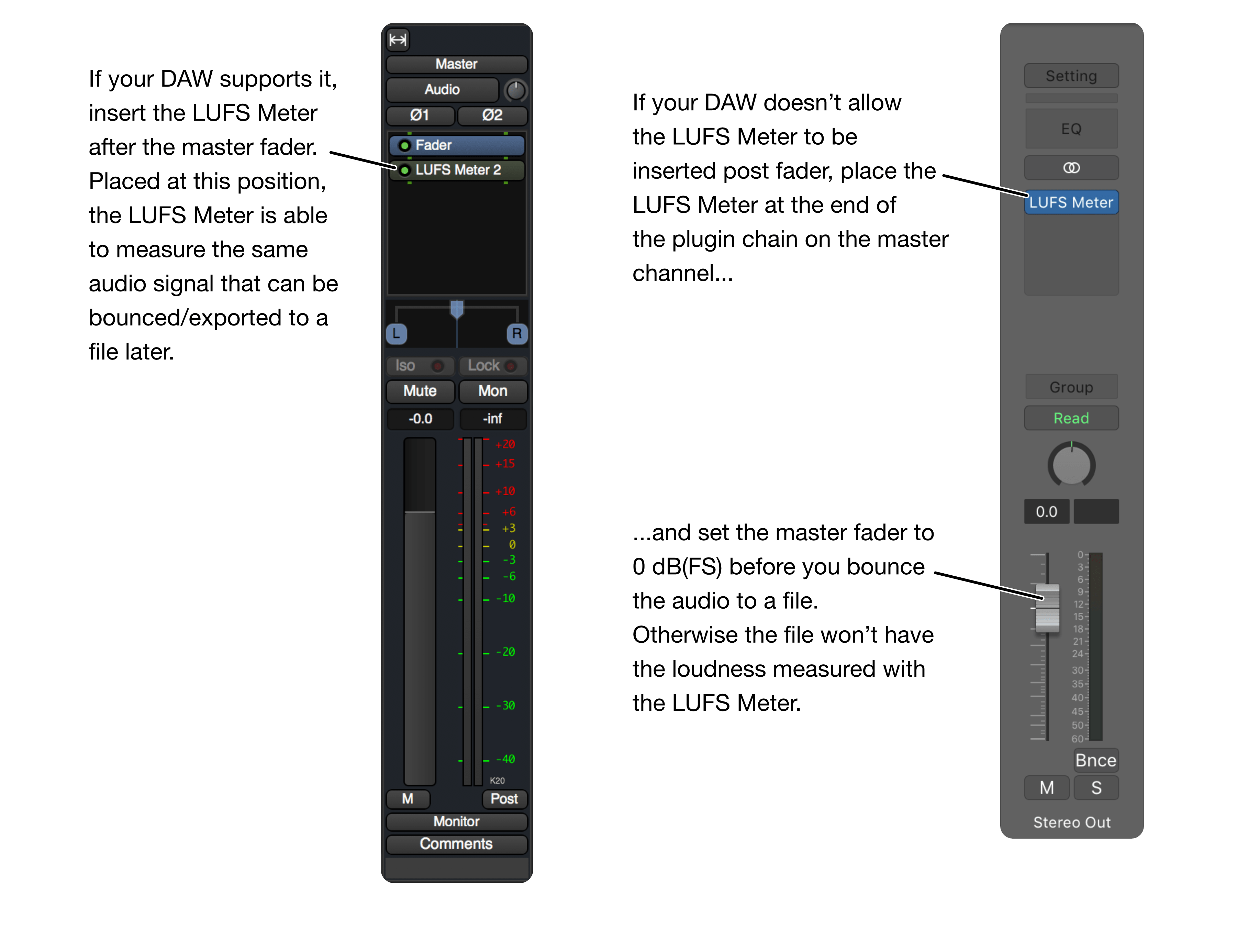
Measure
The steps to measure the loudness are exactly the same as in the single track chapter before.
Adjust the loudness
It is often required to deliver audio with a specific loudness. The LUFS Meter is well suited for this task.
- Place the LUFS Meter plug-in at the end of the processing chain and measure the loudness, as described in the chapter 'Measure the loudness of an entire multitrack project'.
- Set the desired target loudness.
- Click the 'adjust to' button.
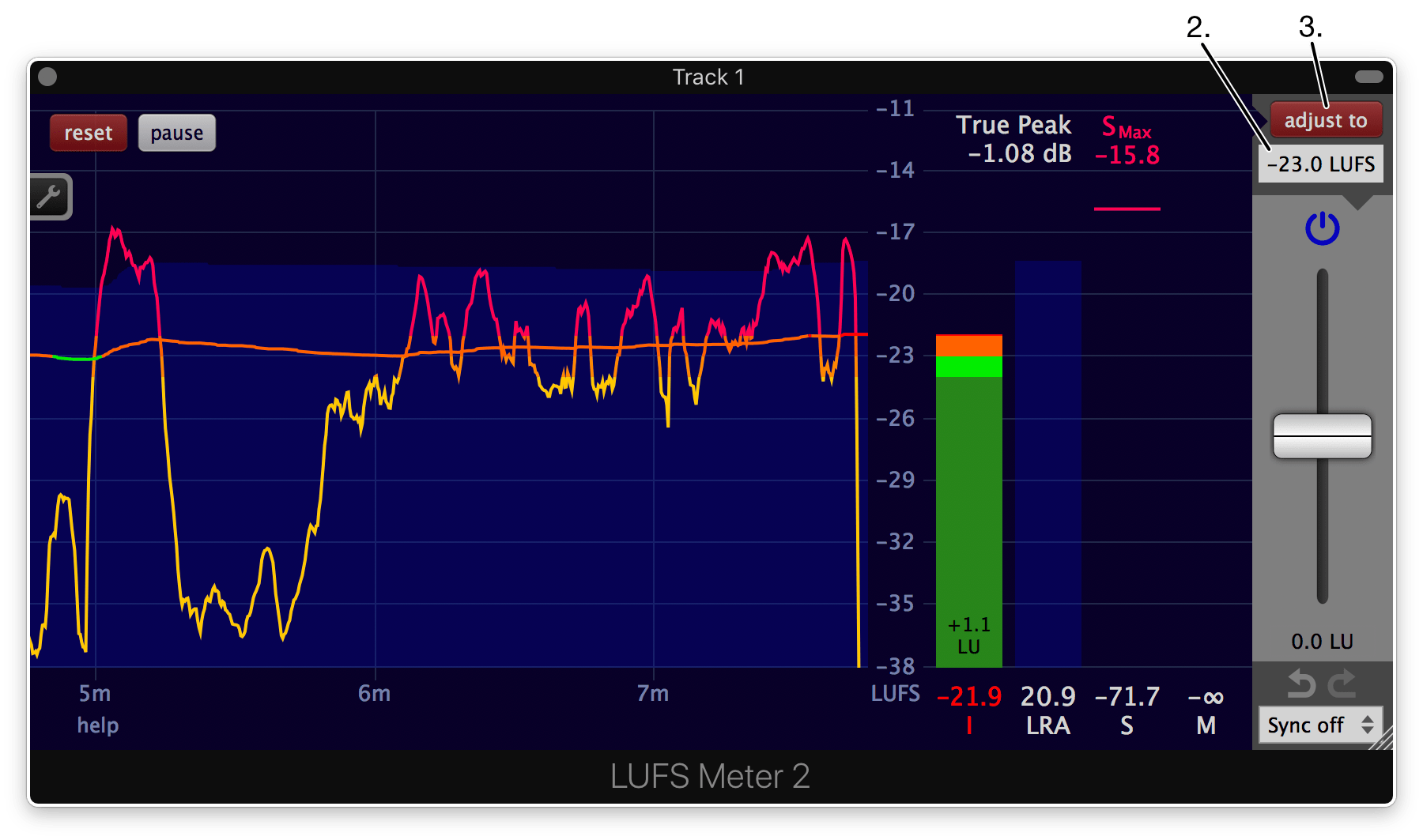
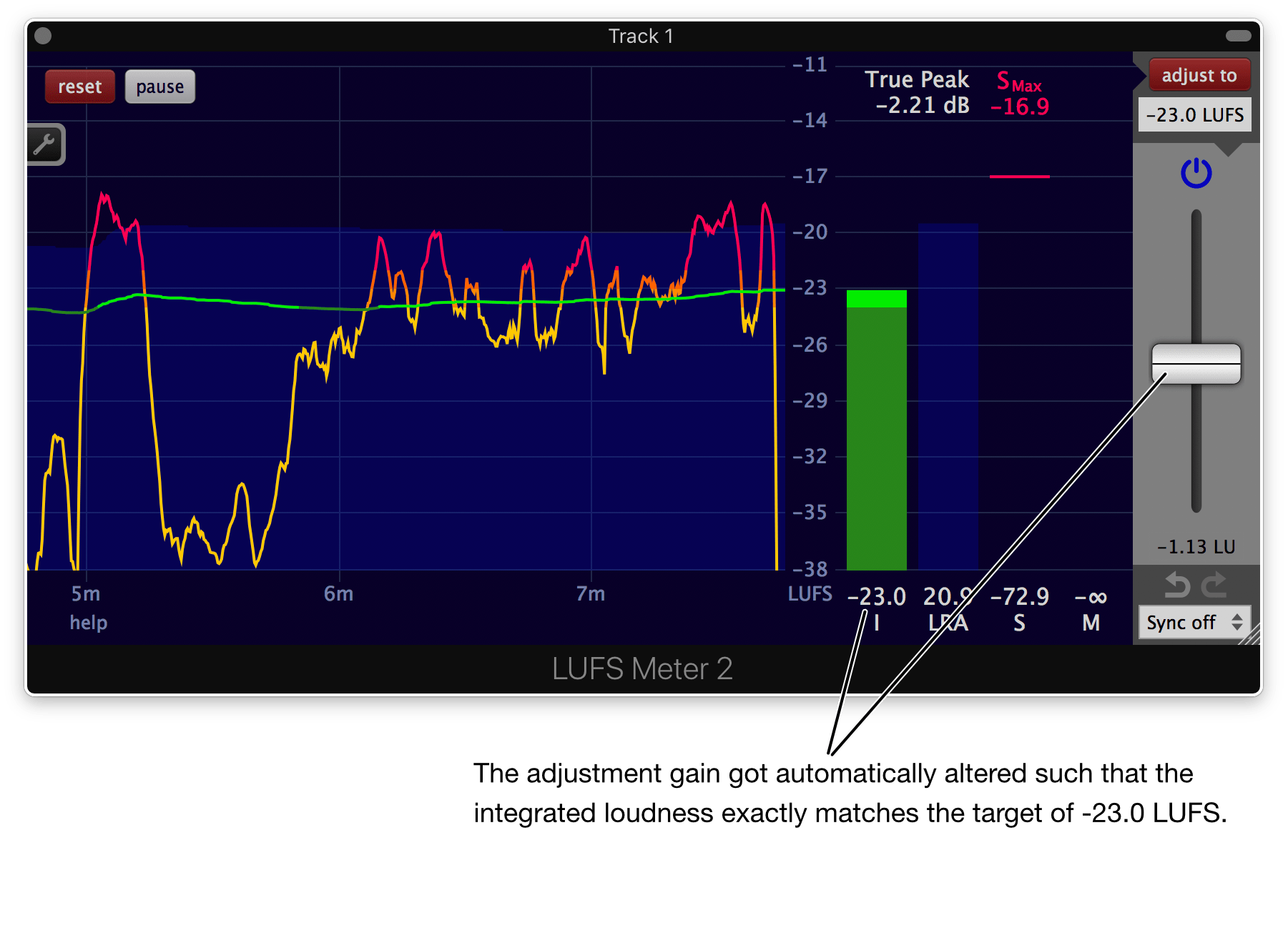
This procedure is also described in a short video.
Many DAWs offer the option to normalise when exporting or rendering an audio file. Make sure to disable this normalisation to preserve the loudness.
Measure and adjust as fast as possible in a DAW (offline processing)
Like every plug-in in a DAW (using the common VST, VST3, AAX or AU plug-in specification), the LUFS Meter can't access the entire audio content of a track at once. It only can "hear" the audio at the current playhead position.
Because the entire audio content has to pass through the LUFS Meter in order to get the integrated loudness, measuring the loudness with a plug-in in a DAW is quite slow (realtime).
Luckily, in almost every host passing audio through the LUFS Meter can be accelerated tremendously by using a faster-than-realtime offline processing option, often called 'render to disk', 'bounce', 'export' or 'freeze'.
In Pro Tools, the Audio Suite version of the LUFS Meter is very handy for offline processing.
In Logic, use one of the options available under File -> Bounce.
In Reaper, use File -> Render... or press Command-Alt-R (Mac) or Ctrl-Alt-R (Windows and Linux).
Videos:
Synchronisation
The LUFS Meter offers two distinct synchronisation mechanisms.
- Multiple LUFS Meters can be synchronised with each other.
- The LUFS Meter can react to playback changes of the host - like start and stop of the playback.
Synchronise multiple LUFS Meters (Sync groups)
At the bottom right, a sync group can be selected. It can also be set in the Sync settings.
If multiple instances of the LUFS Meter belong to the same sync group, clicking the reset button on one of them will reset the others as well. The same goes for the 'pause', the 'adjust to', the 'adjustment power', the 'undo' and the 'redo' button.
To set the adjustment gain to zero in all instances within the same sync group, hold the Alt-key and double click on the adjustment gain fader. Hold the Alt-key and click and drag the adjustment gain fader to simultaneously change the adjustment gain of all instances belonging to the same sync group. Their relative gain differences will be preserved.
In order to work, all synced LUFS Meters need to be of the same kind. E.g. a VST and an AU LUFS Meter are not able to synchronise. That's because they don't share any common memory.
Synchronisation with the host
The LUFS Meter can reset and pause the measurement as well as adjust the loudness automatically when the playback of the host starts or stops. The desired behaviour can be set in the Sync settings.
Create a faders up mix
Introduction
Getting started on a new mix can be time consuming, especially if the project contains a lot of tracks.
A helpful starting point is the initial faders up mix, where all tracks are set to the same loudness, such that all of them can be heard clearly.
Different ways exist to achieve such a faders up mix. One can create it manually by listening and adjusting the levels of the individual tracks until everything sounds equally loud. But this is a time consuming process. Another method is to listen to each track in isolation and adjust it's level such that it aligns with a reference pink noise signal.
The LUFS Meter and the Multimeter provide a third method, based on their unique synchronisation features. This is the fastest way to create a faders up mix. How to do this with the LUFS Meter is described next.
This procedure is also described in a video.
Step 1. Track faders
Set all track faders to the same position.
It is recommended to set them to unity. Because faders on most DAWs have finer resolution around their zero position.
Step 2. Add the first LUFS Meter
A LUFS Meter will be added to each track. Before doing so, only add one LUFS Meter to your first track. If this track already contains plug-ins, add the LUFS Meter after the last plug-in.
In the LUFS Meter, turn off the true peak measurement to save processing power. It is not needed for this application. Also enable synchronisation by choosing a sync group.
Either set these two options manually, or choose a preset
like the 'faders-up mix, I & S', where these two options are
already set correctly for this application.
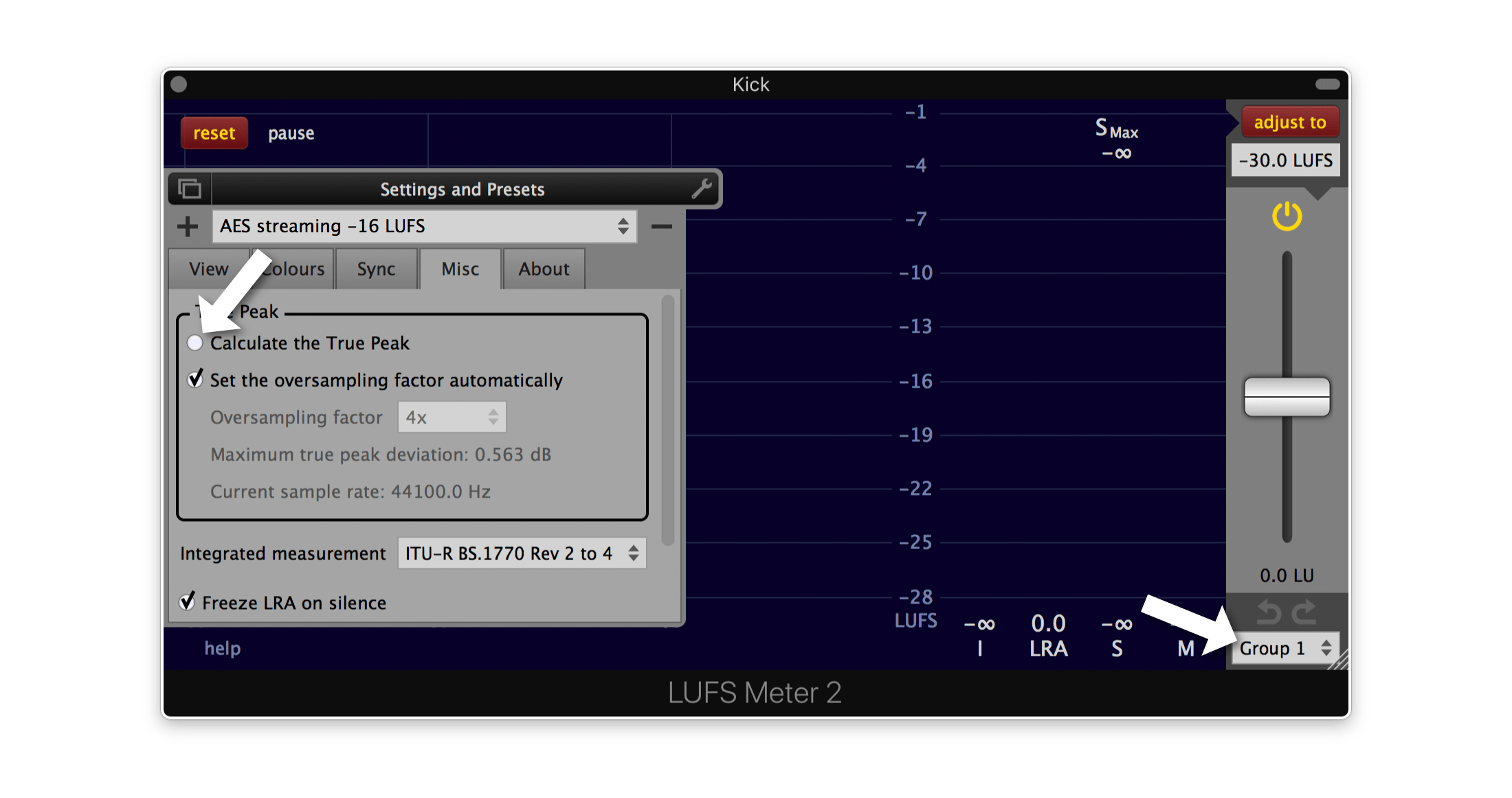
Step 3. Copy this LUFS Meter to the other tracks
Copy this LUFS Meter to the remaining tracks. Insert it after the last plug-in on each track. Since you copy it, all LUFS Meters do belong to the same sync group.
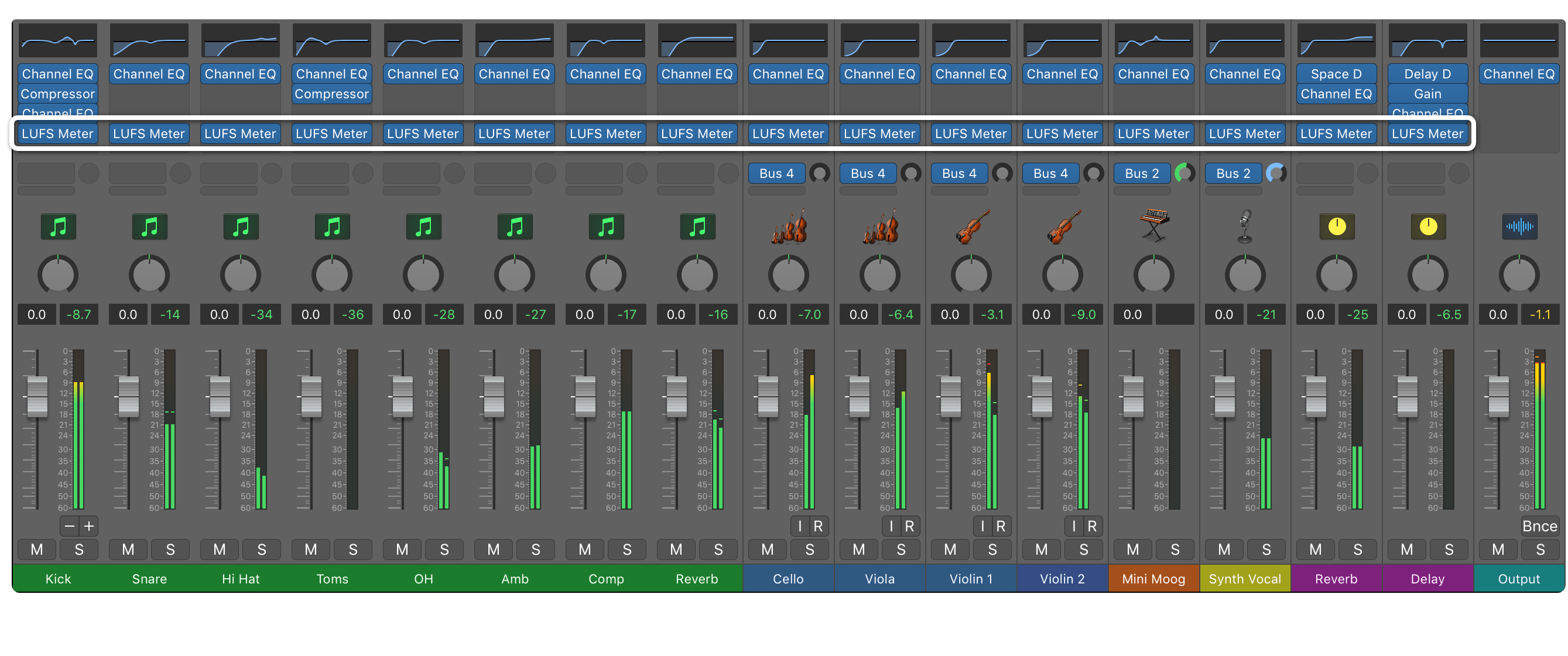
Step 4. Measure the entire project
Open one of the LUFS Meters and click the reset button. Because of the enabled synchronisation all other LUFS Meters will also reset.
Play the project from start to finish, such that each LUFS Meter can measure the audio of its track. This can be accelerated by utilising the offline processing capabilities of your DAW.
Step 5. Adjust all tracks at once
Press the 'adjust to' button on one LUFS Meter. All other LUFS Meters will also adjust their corresponding track.
The faders up mix is now created.
To turn off the measurement of all LUFS Meters, press the pause button. Now the LUFS Meters operate as simple gain plug-ins with a neglectable hit on your processor.
If the sum of all tracks is too loud or is clipping the master bus, either
- Lower the adjustment target on one of the LUFS Meters and click the 'adjust to' again. No need to re-measure. This works because the adjustment target also is synchronised between all instances of the LUFS Meter belonging to the same sync group.
- Turn down the level of the master track or insert a gain
utility at the beginning of the plug-in chain on the master
track and turn its gain down. This works without any
clipping in the signal path, because all DAWs known to
Klangfreund work with huge headrooms internally.
(In need of a gain utility? If pause is enabled, the LUFS Meter is a nice gain utility that uses virtually no ressources of your computer.) - Turn down all track faders by the same amount.
Undo and redo
This is optional. You might want to compare the mix before and after the adjustment. To do so, click the undo button below the adjustment gain. All adjustment gain faders of the synchronised LUFS Meters will jump back to their position before the 'adjust to' button was clicked. Now you can listen to the mix before the gain adjustment of the synchronised LUFS Meters is applied. Click the redo button on the right of the undo button and you are back at the faders up mix.
This works because Klangfreund has developed a unique undo history for the LUFS Meter capable of keeping track of an arbitrary amount of synchronised instances of the LUFS Meter.
Re-adjust while mixing
After the faders up mix you most likely will use the track
faders to find a sweet loudness balance between the different
tracks. Lets call this state SLB.
This SLB wont last long. As soon as the dynamic of a track
gets changed or if some equalization is applied, the tracks
loudness will also change and the SLB is destroyed.
If only one track was altered, manually adjusting the track fader (or a gain plug-in somewhere before the LUFS Meter) is the fastest way to get back to the SLB.
But if multiple tracks have been changed it might be faster to reinvoke the LUFS Meters and to let them do the adjustment. To do so, turn off the pause, push the reset button, play back the entire project and click the 'adjust to' button again. Because the track faders are still in the SLB position, this will result in the SLB again.
Judge effects effectively
If not in a hurry, an audio engineer can easily spend hours building and tweaking effect chains on a single audio track to achieve a mind blowing sonic masterpiece (Or more realistically, to fix a poor performance or a bad recording..). During this process it is essential to continuously compare the unprocessed signal (before the effects) with the processed signal (after the effects). No one wants to get a worse sounding result after all the effort.
But there's a catch. If an effect slightly degrades the audio quality, but at the same time increases the loudness, it is perceived as better sounding - A psychoacoustic effect one needs to take into account. Luckily there exists a countermeasure to not be fooled: Adjust the unprocessed and the processed signal to the same loudness before performing the critical listening camparison. The LUFS Meter comes in handy for this task.
...in Reaper
For the sake of simplicity, the project shown here only contains one track with one effect.
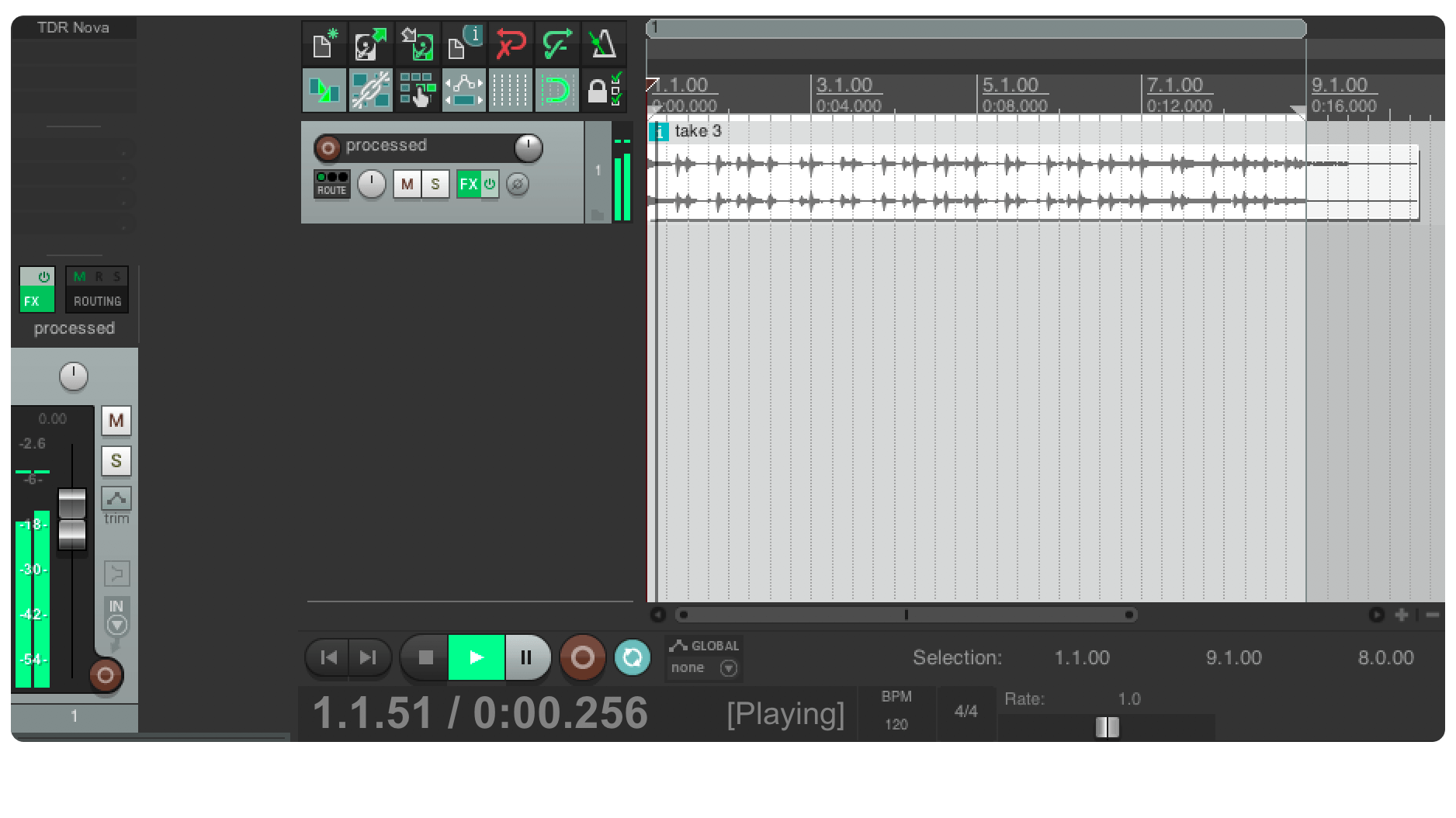
Add a second track by double clicking below the current track (Named 'clean' in this example).
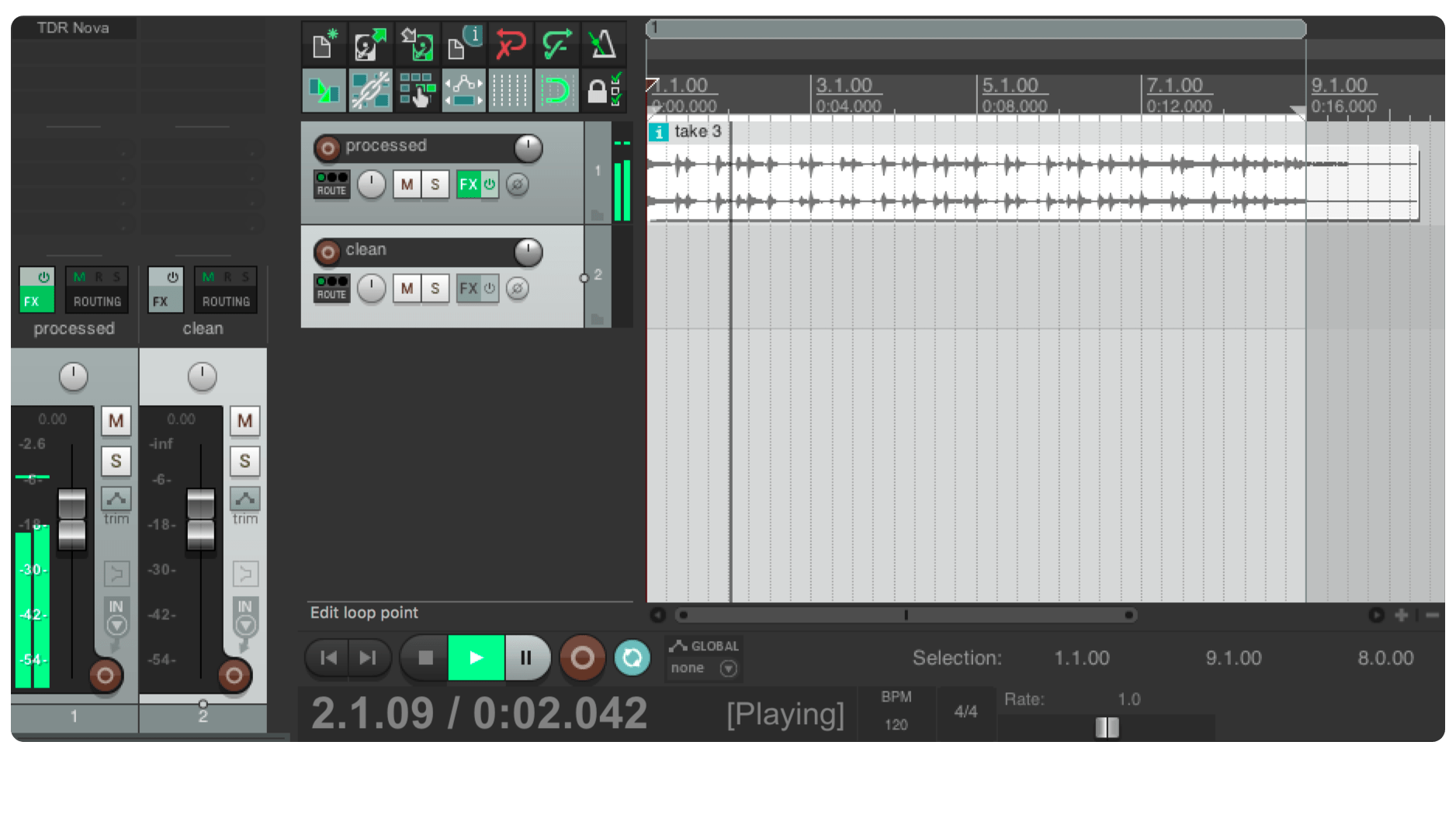
Route the audio of the first track to the second by grabbing the route icon of the first track and drop it over the second track. A pop-up window appears where you can choose at which position of the first track the audio should be taken. Choose 'Pre-FX', such that the second track will receive the unprocessed audio.

Close the pop-up window and add a LUFS Meter to your first track. It needs to be the last effect on that track for this application. Enable the synchronisation of the LUFS Meter by choosing a sync group.

Drag and drop the LUFS Meter from the first track to the second track. This will create a copy of the LUFS Meter with the same settings as the first one. In particular: Both belong to the same sync group.
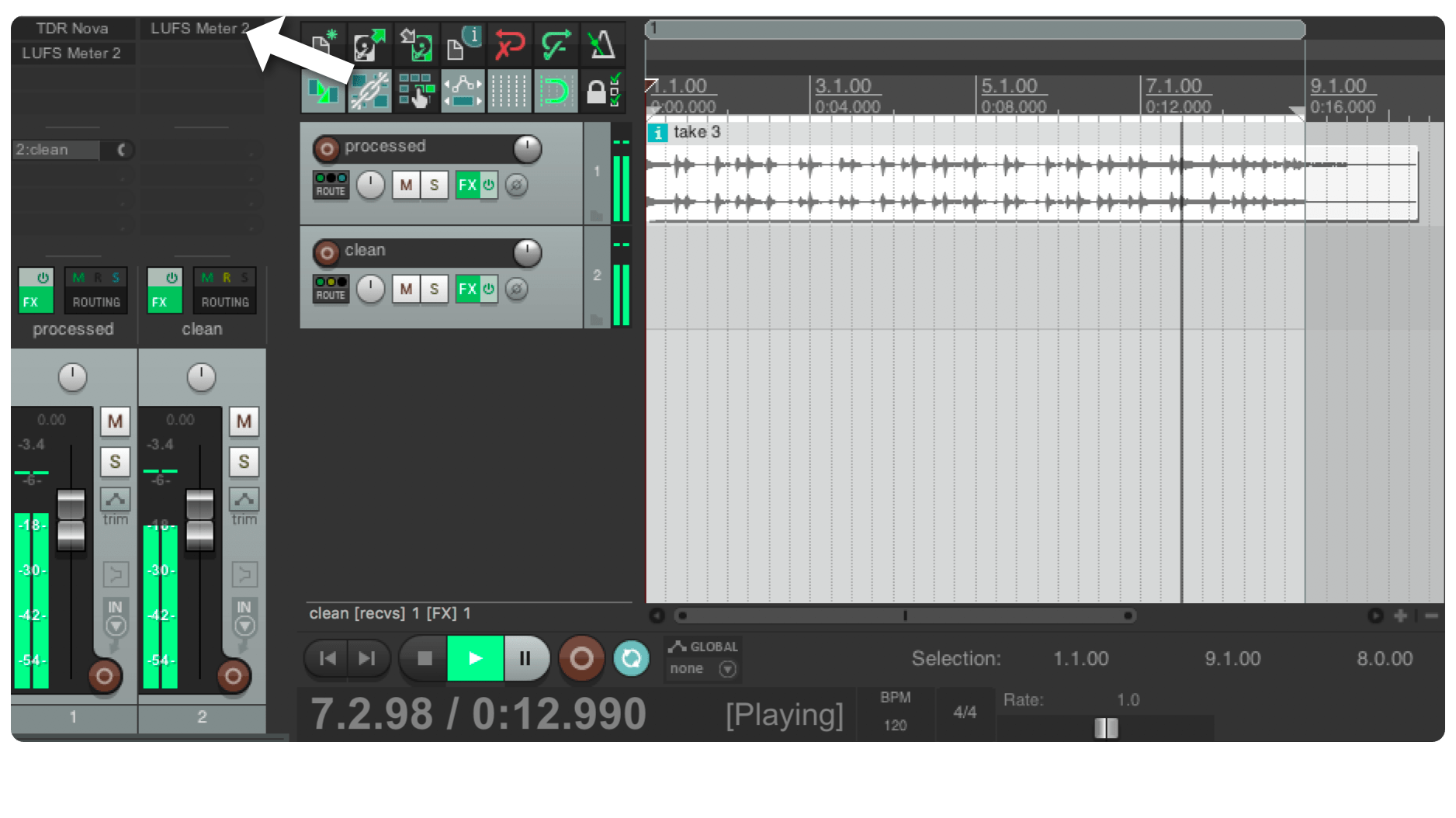
The first LUFS Meter now receives the processed audio (In this example by the TDR Nova plug-in) and the second LUFS Meter receives the unprocessed audio.
Measure and adjust the loudness with one of these LUFS Meters (the loudness target for this application can be chosen to personal taste). Because of the enabled sync feature the first as well as the second track are now loudness adjusted. Or stated differently, the clean as well as the processed track are now equally loud. To hear both tracks at an equal loudness, make sure that the channel fader of the second track is at the exact same position as the first one.
Now you are able to compare the processed and the clean signal by listening exclusively to each of these two tracks using the solo buttons (Hint: Click the S button while holding the Command/Ctrl and the Alt key. This will un-solo every other previously toggled solo button).
There is one caveat in Reaper. If you solo the first track, you will also hear the second one, even if the solo button of the second one is not lit. To avoid this, click the mute button of the second track.
This is how to listen to the processed signal:

And this is how to listen to the clean signal:

... in all hosts
The goal is to compare the signal before the effect(s) with the signal after the effect(s) at the same loudness. Here are some ideas on how to achieve this:
If your host supports it, route the (dry) pre effect signal to an empty track. This is actually exactly what has been described in the previous section for Reaper.
Another strategy is to add one LUFS Meter before your effect(s) and a second one after the effect(s). Don't synchronise these two LUFS Meters. Create an effects group containing the effect(s) and the second LUFS Meter. Analyse and adjust the loudness with the first LUFS Meter. Repeat this with the second LUFS Meter (contained in the group). The output of boths LUFS Meters are now adjusted to the same loudness. Via the bypass (on/off) toggle of the group you can now listen to the dry as well as to the processed signal.
A third option, applicable in all hosts:
Add a LUFS Meter after the effect(s). Duplicate the entire
track with all the contained regions and effects. Remove the
effect(s) you wan't to judge from the duplicated track but keep
the LUFS Meter. Adjust the loudness of both tracks by
using the LUFS Meters on each track. Now you can
solo one of the tracks, listen carefully, solo the other track
and listen again. Toggle back and forth as many times as you want
to figure out if the effect(s) make your track sound better or
worse.
Compare your work with reference tracks
To achieve beautiful results it's crucial to compare your work with reference tracks while you are working on it.
A proven strategy is to bounce/export your work to an audio file and put it into a new project. Together with some reference tracks, each one on a separate audio track. Use the solo feature of your DAW to listen to the individual tracks. Take notes about possible improvements in your own work. Go back to your original project and work on these issues.
There is one catch though. A slightly louder track sounds better to the human ear - Even without detecting it is louder. That's why it is important that all the tracks in the comparison are equally loud.
To adjust your work and all the reference tracks to the same loudness, proceed exactly as described in the chapter Create a faders up mix. The only difference is that this time you will listen to the individual tracks in separation - via the solo feature of your DAW.
Comply with a high loudness target
The original idea of using a low integrated loudness target like -23 LUFS is that there is plenty of headroom available, such that a limiter on the master bus is only rarely triggered.
Though for some applications, like music listening on mobile devices, targeting a higher integrated loudness might be required, for example -16 LUFS. A lot of material adjusted to -16 LUFS will have its true peak exeeding 0 dB(TP) which can result in audible clipping in the final audio file. This section describes how to use the LUFS Meter in conjunction with a limiter to reach an integrated loudness of -16 LUFS and a true peak of -1 dB(TP) or below.
The stock limiter 'MGA JS Limiter' in Reaper is used here, but any limiter will do. Be prepared to spend some time tweaking the parameters to get a pleasing sounding result. Also try different limiters, they often sound quite different.
Initial analysis
To follow along you can download the drumloop used in this example.
Load the drumloop in your DAW and add a LUFS Meter to its track and measure it. You can speed up this process by utilising the offline processing capabilities of your DAW.
The LUFS Meter reveals that this drumloop has an integrated loudness of -25.6 LUFS and a true peak of -5.86 dB(TP).

If it is required to deliver this piece of audio with a program loudness below -16 LUFS and a true peak below -1 dB(TP) this is easy to achieve. Just increase the adjustment gain of the LUFS Meter until the first of the two values reaches its specified limit. In this example, it is the true peak.

The output has now an integrated loudness of -20.8 LUFS and a true peak of -1.0 dB(TP).
Limiting
If it is required to deliver this piece of audio with a program loudness of EXACTLY -16 LUFS and a true peak below -1 dB(TP) this isn't as straightforward as before. By choosing the integrated loudness target -16 LUFS at the top right and clicking the 'adjust to' button...
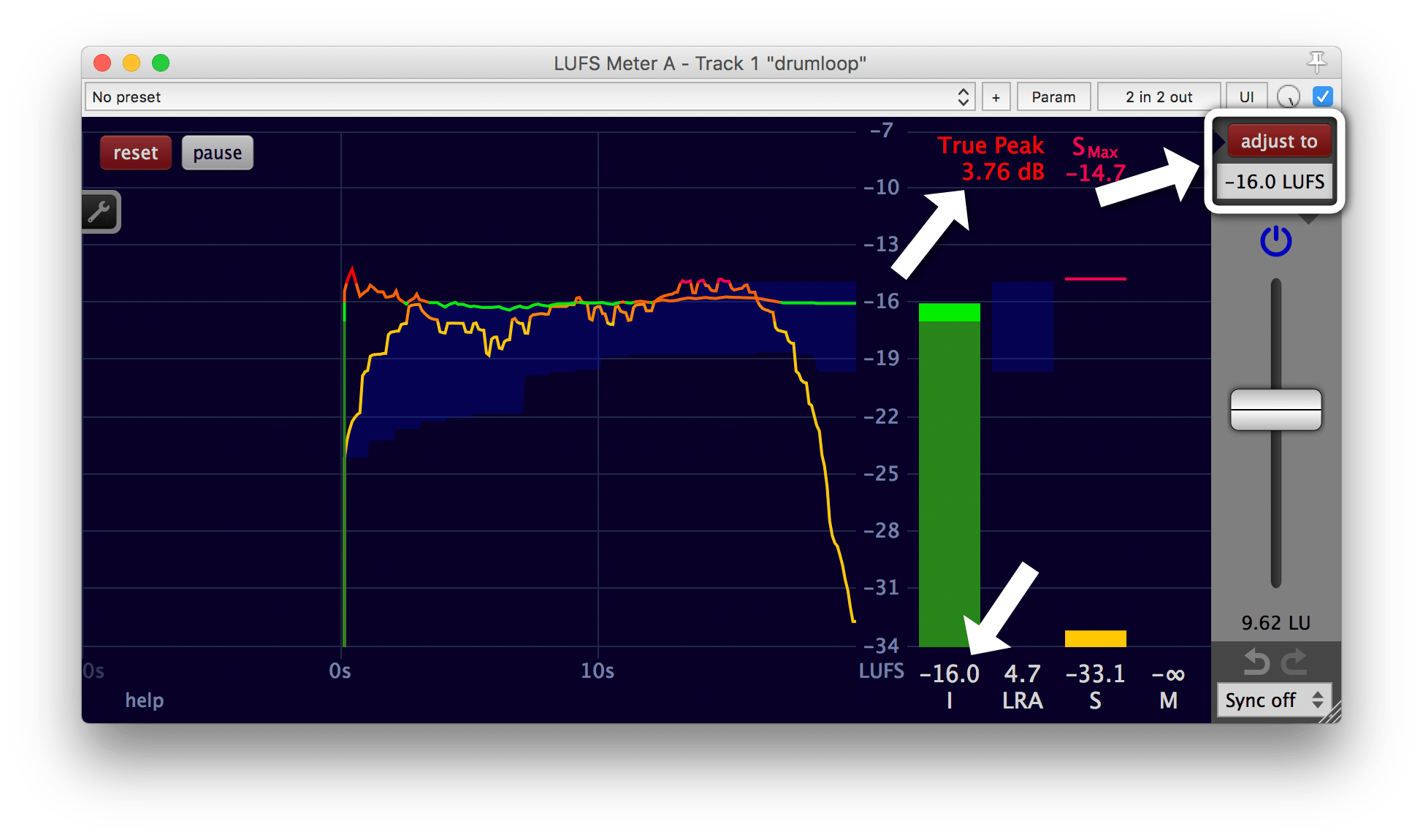
the readings are now I = -16 LUFS and true peak = 3.76 dB(TP). The true peak is much higher than the maximal allowed -1 dB(TP).
We need to alter the dynamics. This can be done by surgically editing the volume automation or by using a limiter. Here, the MGA JS Limiter included in Reaper is used to demonstrate how to get there with a stock plug-in that comes with the DAW. The MGA JS Limiter doesn't offer inter-sample peak detection (which is needed to directly detect the true peak within the limiter) but it is still possible to achieve the desired result. The process described here can be applied to almost any limiter at hand.
Add the limiter after the LUFS Meter.
At first, one might tink that this chain (LUFS Meter -> limiter) will take care of the problem at hand: The LUFS Meter will adjust the loudness to -16 LUFS and the limiter will - after some tweaking - ensure that the true peak will stay below -1 dB(TP).
This might even work with audio containing only very few peaks exceeding -1 dB(TP). But in general, the limiter will change the loudness as well. And a further gain adjustment is needed.
This can be verified with ease by adding a second LUFS Meter after the limiter.

In the first LUFS Meter the adjustment gain is already set such that the audio on its output has a loudness of I = -16 LUFS. It doesn't need to perform the measurement anymore. To save resources, enable the pause.
Let's measure the output of the limiter with its default settings with the second LUFS Meter. It reveils that the true peak after the limiter is now lower, at 0.27 dB(TP) (Before the limiter it was at 3.76 dB(TP)). But the second LUFS Meter also uncovers the side effect of the limiter. The limiter changed the loudness. It is now at I = -17.1 LUFS.
Hit the 'adjust to' button on the second LUFS Meter and the loudness will be adjusted to the desired I = -16 LUFS. The applied gain change of +1.05 LU also affects the true peak, which is now higher as well, at 1.32 dB(TP).
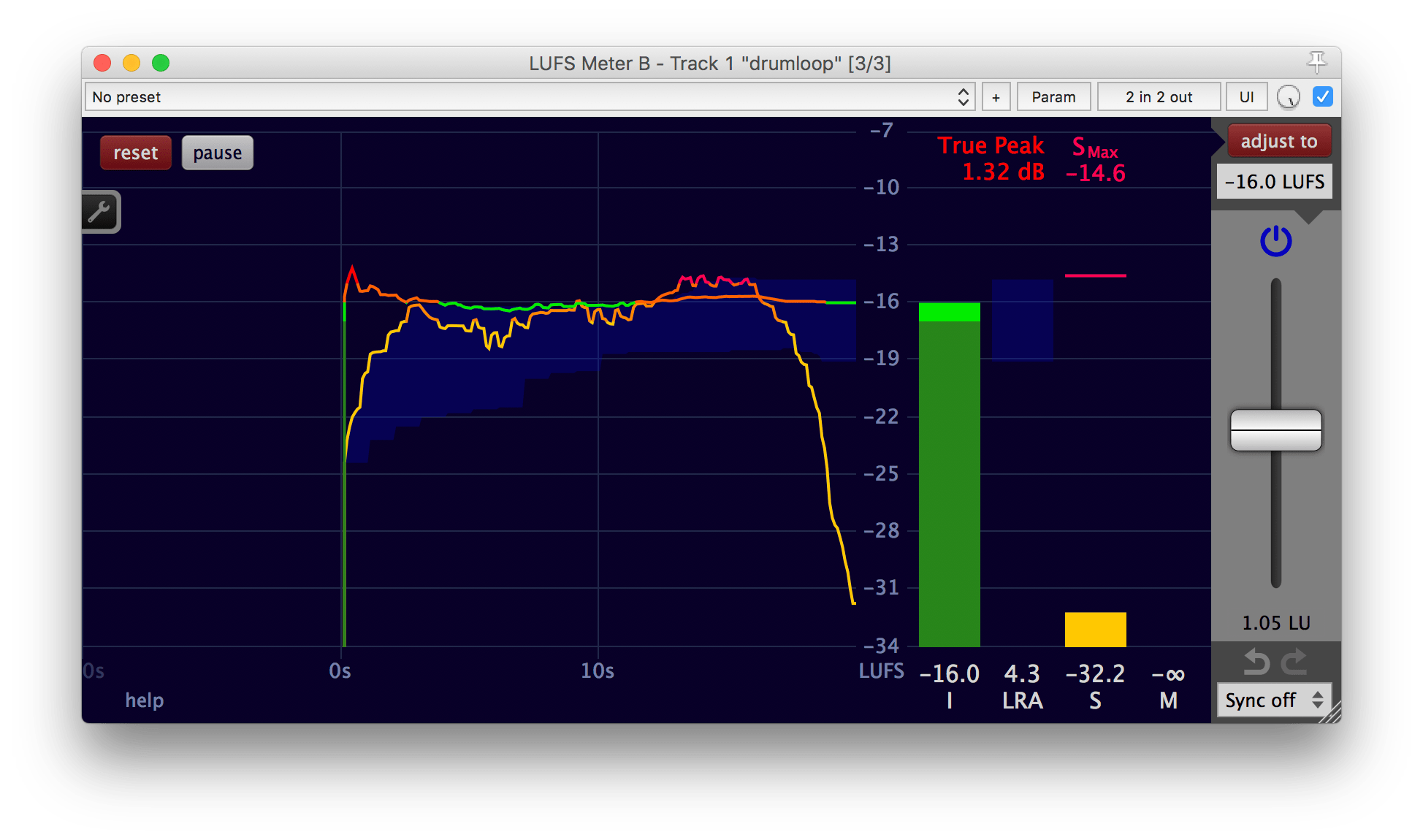
Don't be too disappointed. Even though the true peak is not yet at the desired -1 dB(TP), it is already much closer to the target than before the limiter (3.76 dB(TP)).
To bring the true peak further down, either increase the loudness of the input to the limiter or adjust the parameters of the the limiter, such that the limiter will work more aggressively. In this example, the input gets increased by increasing the adjustment gain of the first LUFS Meter.
The required input boost can't be quickly calculated, because without further knowledge about the exact algorithm the limiter uses it is almost impossible to predict how much the limiter will alter the loudness. But luckily it only takes a few trials of different adjustment gain positions of the first LUFS Meter to achieve the desired result.
Tip 1: Offline processing speeds up each measurement quite dramatically.
Tip 2: To avoid the need to have to repeatedly click the 'reset' button before and the 'adjust to' button after each measurement in the second LUFS Meter, check all options under Settings -> Sync -> Sync with the host. This will toggle 'reset', 'pause' and 'adjust to' automatically and simplifies multiple measurements.
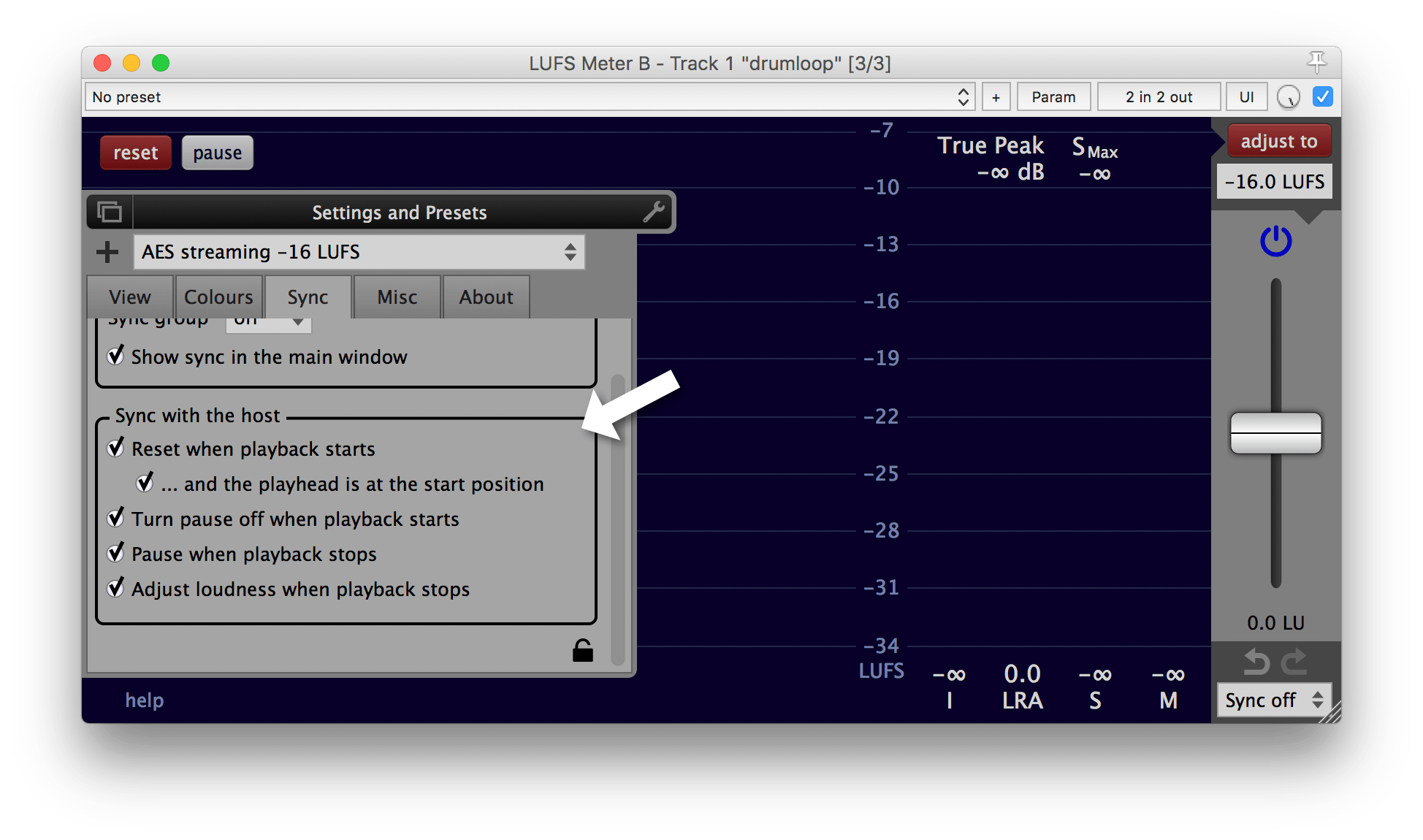
In this example, an adjustment gain of 14.6 LU (I = -11 LUFS) in the first LUFS Meter...
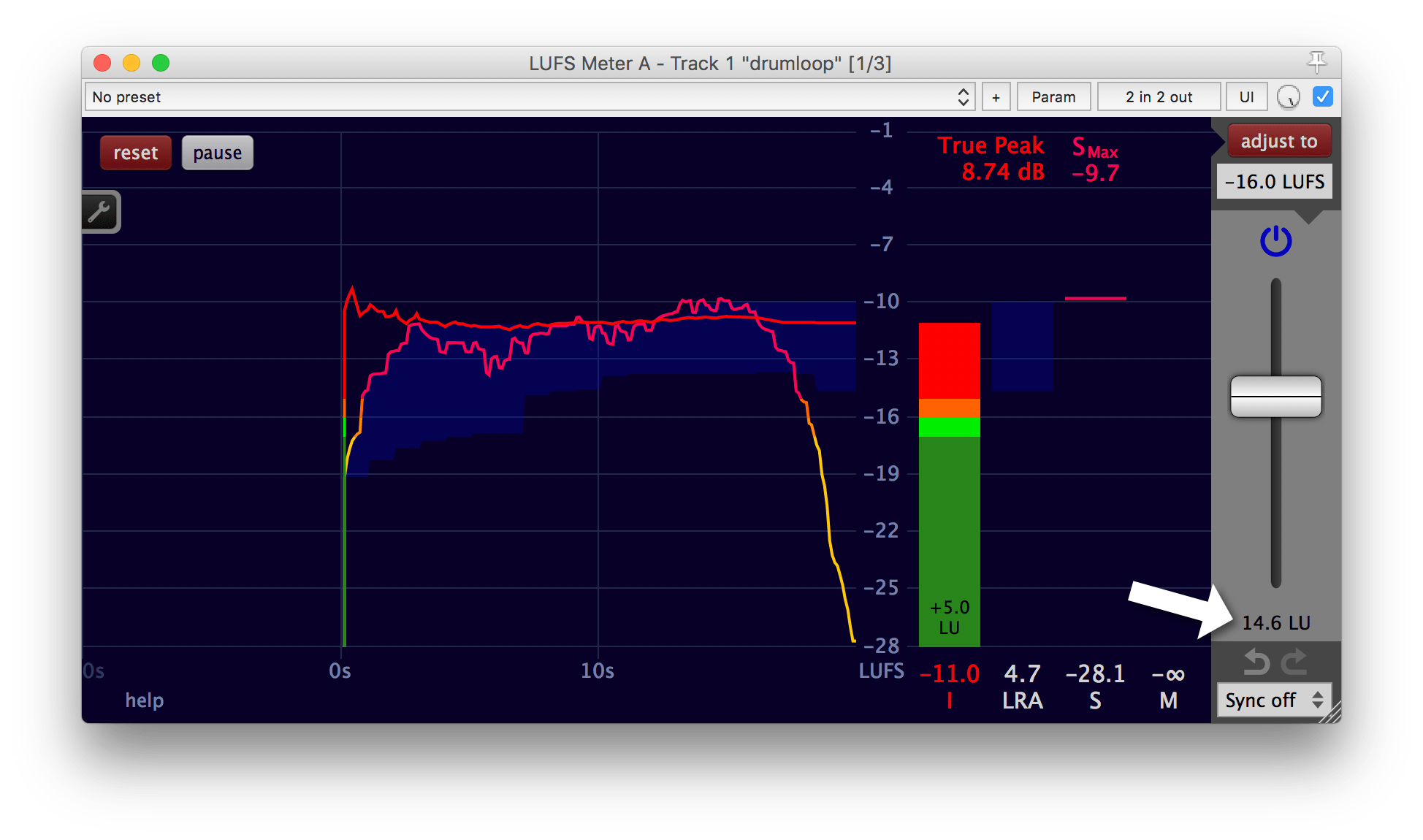
...results in the measurement of I = -16 LUFS and the true peak = -1.02 dB(TP) in the second LUFS Meter. (After the second LUFS Meter adjusted the loudness automatically to I = -16 LUFS.)

Even though it now complies to the desired specification, it is recommended to always tweak the parameters of a limiter until the output is as pleasing as possible for the given material. Remember that the technique described in Judge effects effectively is quite useful for such a task.
Loudness compliance for broadcast
When producing content for broadcasting or streaming services it is often required to deliver loudness compliant material.
If your editing application doesn't have a master bus,
group all clips in the timeline instead.
For example in Final Cut Pro X, select all clips in your
timeline by pressing the Command-A keyboard shortcut...

...and add them to a 'compound clip' by pressing Alt-G.

Drag and drop an instance of the LUFS Meter to this group.

Open the interface of the LUFS Meter. In Final Cut Pro X: Select the compound clip and click the icon next to the 'LUFS Meter' title in the audio inspector.
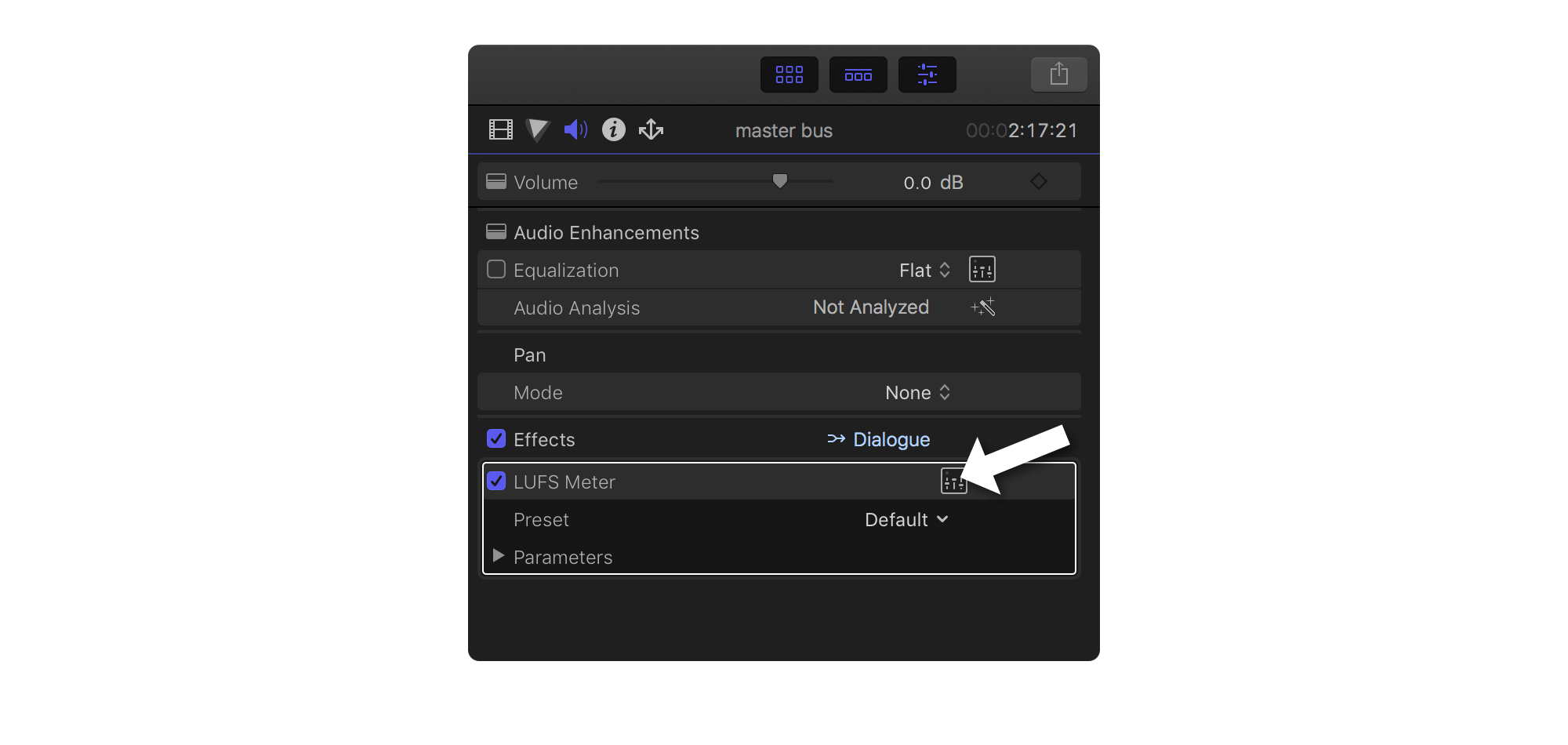
Now the project is ready to be measured and adjusted as described in previous chapters.
Note of caution for Final Cut Pro X: Make sure that the volume slider at the top of the audio inspector of this 'master bus compound clip' stays at 0 dB at all times. It operates on the audio signal after the LUFS Meter and therefore its effect is not detectable by the LUFS Meter. I.e. changing this volume will render the entire loudness measurement and adjustment useless.
It's worth mentioning that the Multimeter offers a file measurement option, which enables you to create loudness compliant content faster. It can also create measurement reports to deliver to your client.
Daisychained LUFS Meters
If multiple LUFS Meters are used in the same processing chain - e.g. if they are connected in series with some processing (like effects or channel faders) in between -, some care must be taken.
Don't measure and adjust on daisychained LUFS Meters simultaneously.
This can easily happen if daisychained LUFS Meters belong to the same sync group. Use different sync groups on daisychained LUFS Meters to prevent it.
An example of why simultaneously operated daisychained LUFS Meters can lead to an unexpected result
Lets assume a constellation like this:
track audio
-> track fx: LUFS Meter A
-> track fader
-> master fx: another plug-in
-> master fx: LUFS Meter B
-> master fader
-> output
where both LUFS Meters have their adjustment gain faders at 0 LU. To further simplify the example, lets assume that the faders are at unity gain (0dB) and the other plug-in doesn't change the audio at all:
track audio
-> track fx: LUFS Meter A
-> master fx: LUFS Meter B
-> output
For the loudness measurement, the track audio gets played from
start to finish. Let’s assume it has a loudness of I = -15 LUFS
and the adjustment target is -25 LUFS. After the playback, the
LUFS Meter A as well as the LUFS Meter B shows that
the audio that passed through them has a loudness of I = -15
LUFS. If you hit the ‘adjust to’ button of LUFS Meter A,
its adjustment gain will be set to -10 LU and the loudness of its
output will be I = -25 LUFS.
At this point of time, the LUFS Meter B has not yet heard
the audio with the applied adjustment of LUFS Meter A. Its
measurement is still at I = -15 LUFS. So if you also hit the
‘adjust to’ button of LUFS Meter B, its adjustment gain
will be set to -10 LU too. Because all it knows is that the last
time it received audio, it received audio with a loudness of I =
-15 LUFS. It does not know that the next time the audio gets
played back, its loudness will be 10 LU lower.
If you now play the audio back, it will have a loudness of I = -15 LUFS at the input of the LUFS Meter A, a loudness of I = -25 LUFS at the input of LUFS Meter B and a loudness of I = -35 LUFS at the output of LUFS Meter B. Even though the adjustment target of LUFS Meter B is set to -25 LUFS.
(If you measure the loudness of the incoming audio of LUFS Meter B again and hit the ‘adjust to’ button of LUFS Meter B afterwards, its output will now also be at -25 LUFS, as originally desired.)
Multiple sync groups
Here are two use cases for multiple sync groups.
One sync group can be used for all the LUFS Meters coming first on each audio track in a project - for the gain staging. Another sync group can be used for all the LUFS Meters that are placed as the last plug-in on each audio track - for the faders up mix.
It can also be quite useful to have a separate sync group of LUFS Meters for a section of instruments that belong together. To e.g. create a faders up mix for all the violas in an arrangement.
Settings and presets
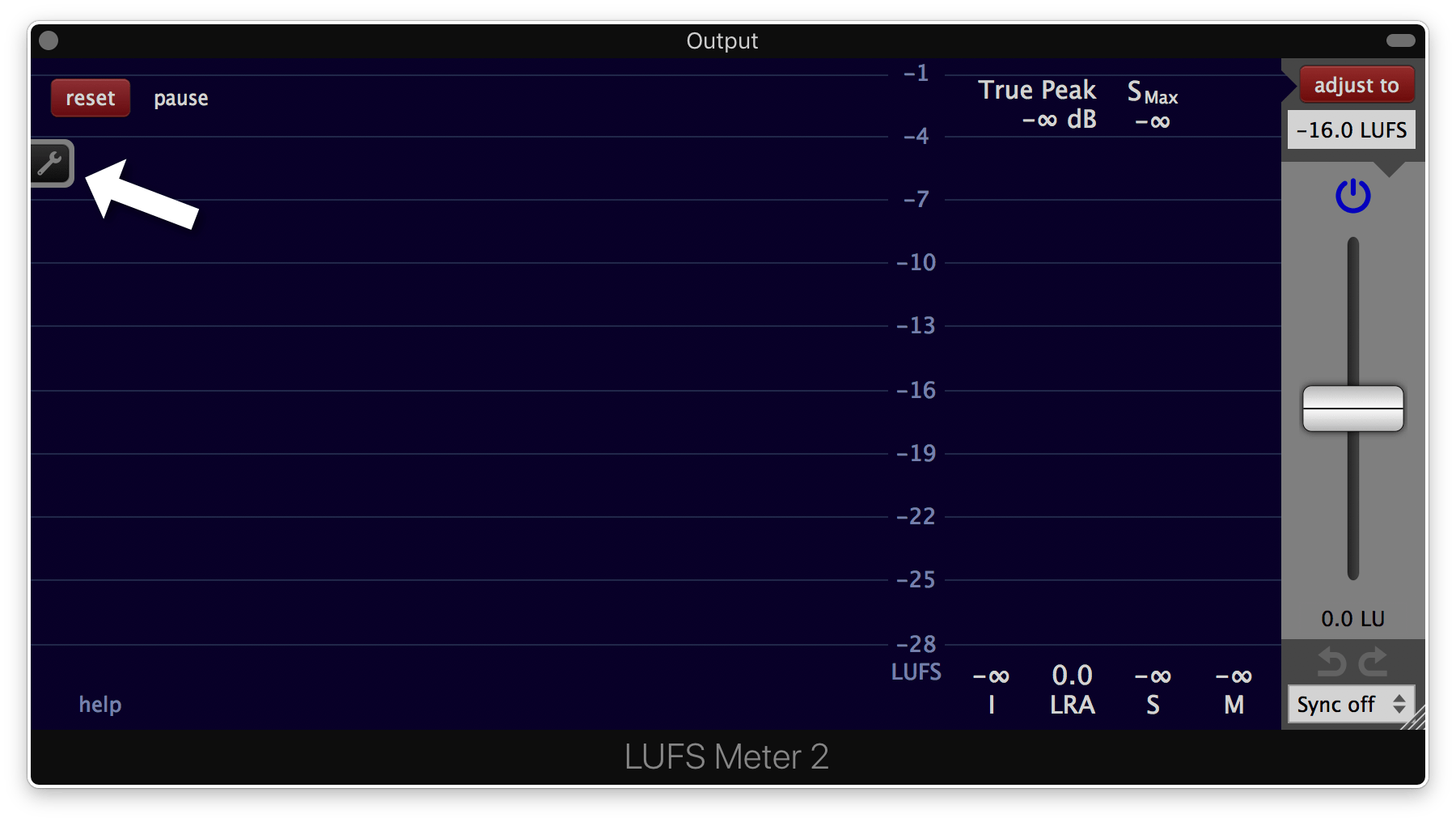
Click the wrench symbol on the left to show or hide the 'settings and presets' panel.
The 'settings and presets' panel can be opened in its own window by clicking the rectangular button on the left side.
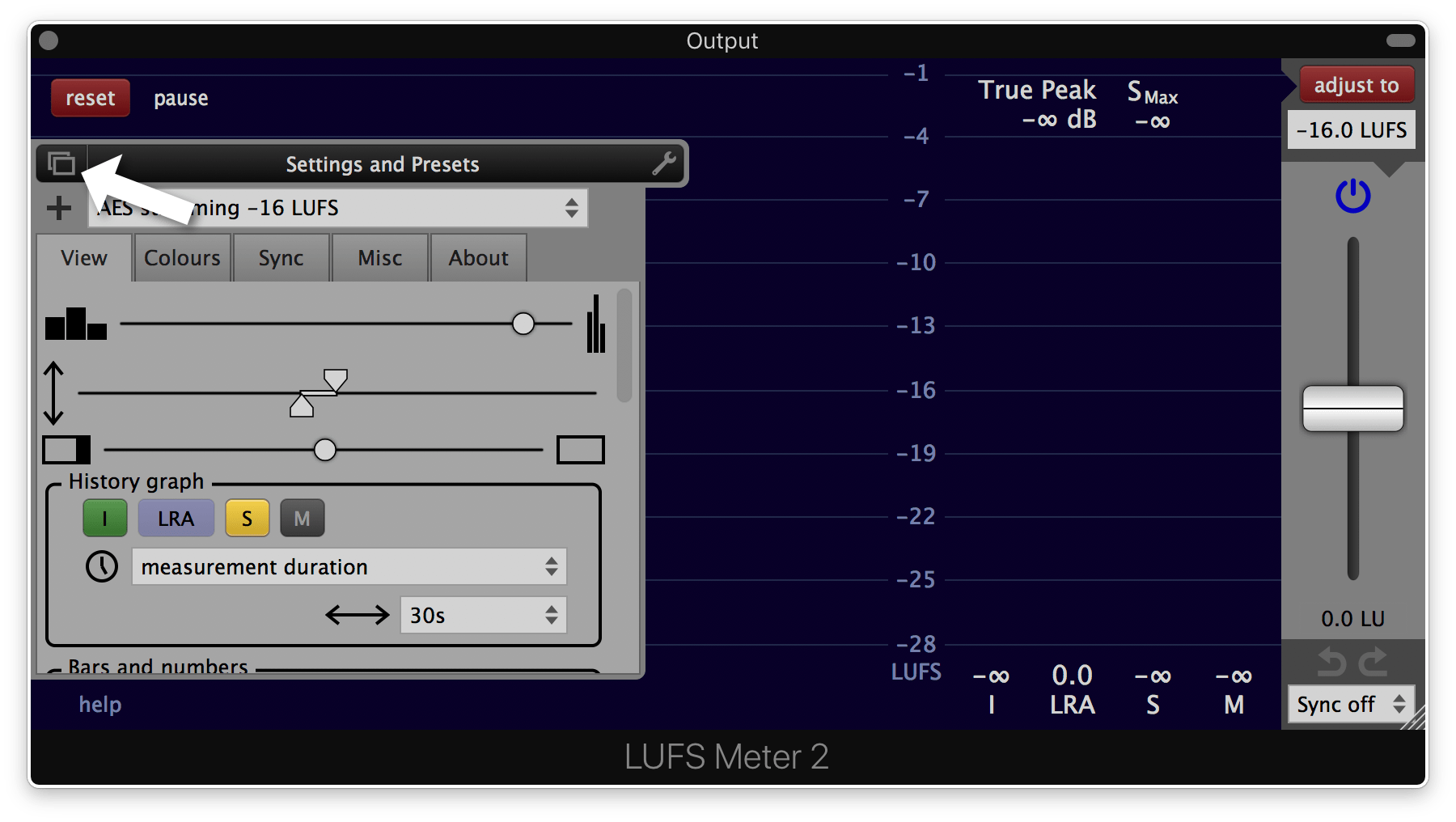
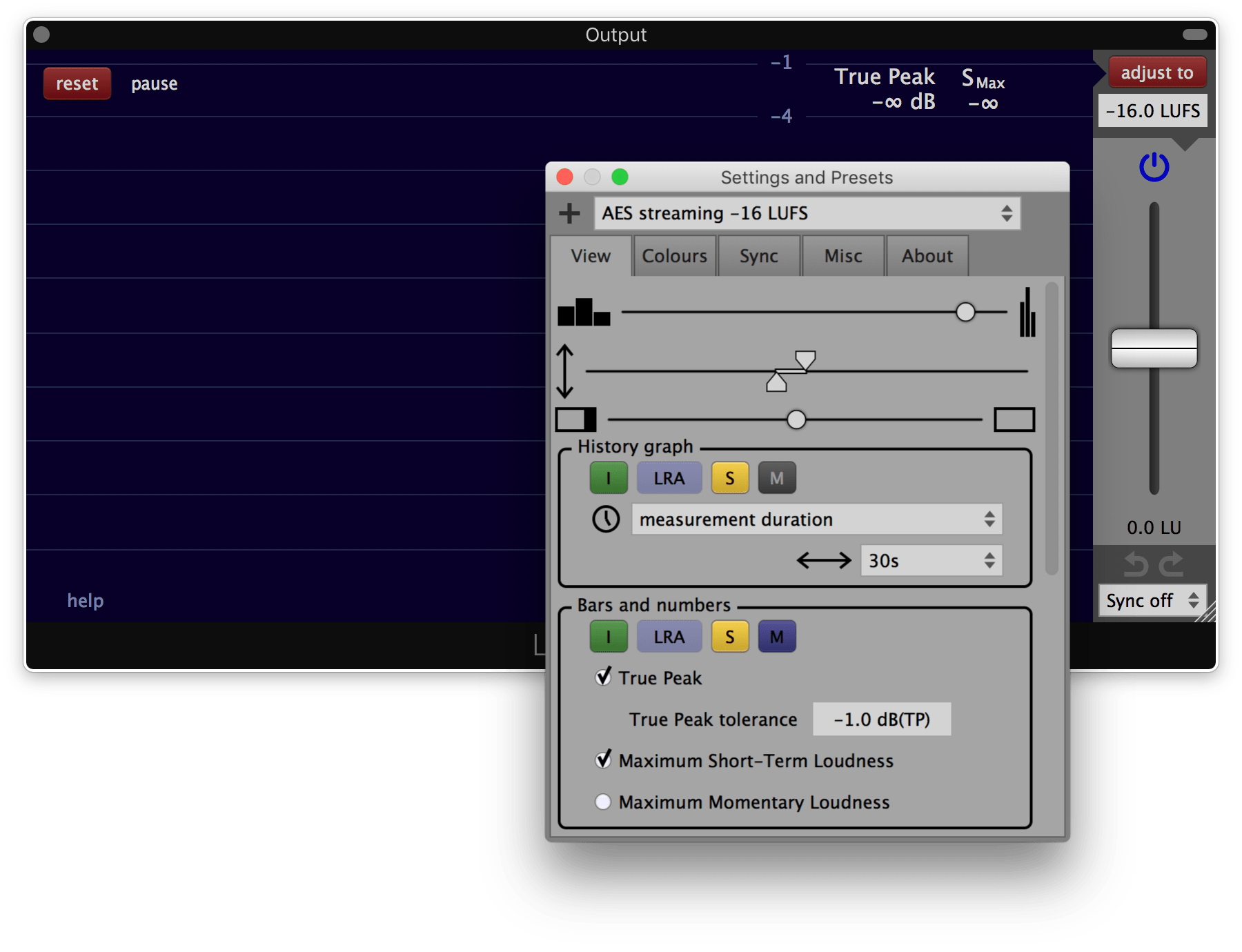
Presets
A preset is a snapshot of all settings. It also contains the size of the plug-in window.
The LUFS Meter comes with a selection of presets for different use cases. They are called factory presets. Factory presets can't be changed or deleted.
Newly created presets are called user presets. Each user preset is stored in a separate file. These files are located at
- macOS:
/Users/<your user name>/Music/Audio Music Apps/Klangfreund/LUFSMeter/UserPresets/ - Windows:
C:\Users\<your user name>\AppData\Roaming\Klangfreund\LUFSMeter\UserPresets\ - Linux:
~/.config/Klangfreund/LUFSMeter/UserPresets/
Load a preset

Select a preset from the preset list at the top of the preferences panel to load it.
Each settings section can be protected from being changed when a preset gets loaded. To enable or disable this protection, click the lock icon at the bottom right of the settings section. A protected settings section has a yellowish background colour.
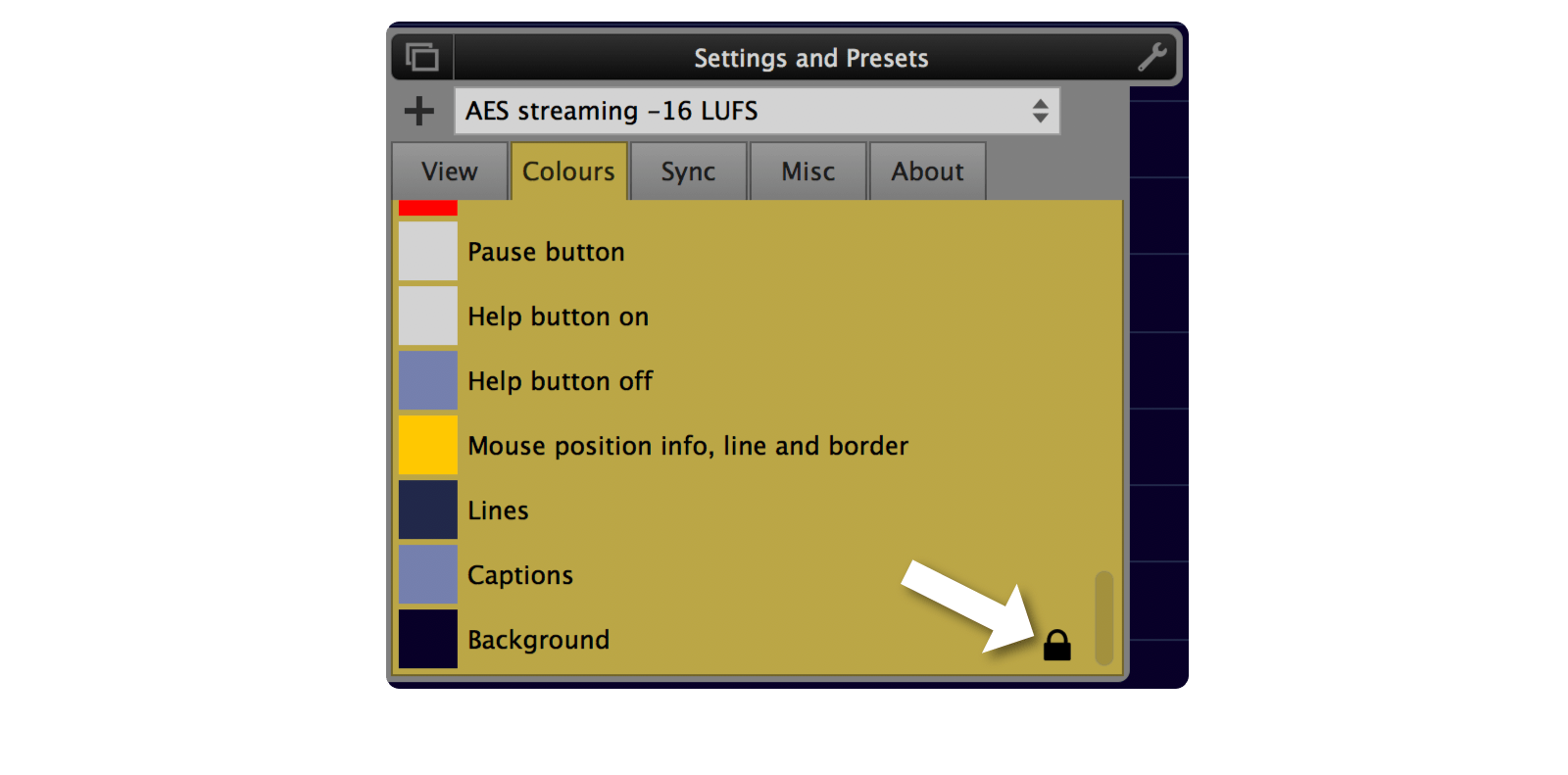
This makes it possible to e.g. switch between different presets while keeping the current interface colours.
Save a preset
Click the '+' button to save the current settings to a new or existing preset.

A dialog with multiple options will appear:

- Create a new preset...
- ... It can be named in the field on the right.
- Replace the current preset. Factory presets can't be replaced. But a user preset with the same name can be created instead.
- Save as the startup preset. The startup preset will be loaded when the LUFS Meter launches. It is stored as a user preset named 'startup'.
Delete a preset

To delete a preset click the '-' button. This button isn't visible when a factory preset is loaded because a factory preset can't be deleted.

A confirmation dialog will appear. Once confirmed, the file of this preset will be deleted from the disk.
View settings

- Loudness bars size.
Sets the size of the loudness bars as well as the size of the text below them. The size of the entire interface can be changed with the 'Interface size' at the end of this settings section (27). - Loudness range.
Specifies the visible loudness range for the loudness bars as well as for the loudness history graph. Can also be changed by click and drag on the loudness caption between the history graph and the bars. - Adjustment section size.
Sets the size of the loudness adjustment section on the right side. If pulled all the way to the right, the adjustment section will be entirely hidden. - Shows or hides the individual measurement graphs
in the history graph.
To show the true peak, the true peak calculation has to be enabled in the Misc section. - Time caption.
Specifies how the time will be displayed in the history graphs. The available options are
'measurement duration',
'time from host: bars, beats, ticks' and
'time from host: seconds'. - Time range.
Sets the visible time range of the history graph. Can also be changed by placing the mouse over the history graph and click and drag vertically with the mouse or by using the mouse wheel.
- Shows or hides the individual measurement bars and
numbers.
- Displays the true peak value.
To display the true peak value, the true peak calculation has to be enabled in the Misc section. - Maximum true peak tolerance.
Sets the threshold at which the colour of the true peak value will change. The maximum true peak tolerance is given in most loudness specifications. If 'auto' is selected, the tolerance is set to the value where an exeeding true peak could actually lead to clipping in the continuous time signal. This is dependent on the sample rate and the oversampling factor used for the true peak calculation. The auto tolerance is equal to the negative maximum true peak deviation set in the true peak area in the Misc section. - Shows the maximum short-term loudness
at the top of the short-term loudness bar.
This value is important for short measurement periods (<2min) according to EBU R 128 s1. - Shows the maximum momentary loudness at the top of the momentary loudness bar.
- Upper tolerance for the integrated loudness.
With the upper and the lower tolerance a target interval can be specified to visually highlight the area around the integrated loudness target. Particularly useful in live applications. - Integrated loudness target.
Sets the integrated loudness target. - Lower tolerance for the integrated loudness.
With the upper and the lower tolerance a target interval can be specified to visually highlight the area around the integrated loudness target. Particularly useful in live applications. - Upper tolerance for the short-term loudness.
With the upper and the lower tolerance a target interval can be specified to visually highlight the area around the short-term loudness target. Particularly useful in live applications. - Short-term loudness target.
Sets the short-term loudness target. - Lower tolerance for the short-term loudness.
With the upper and the lower tolerance a target interval can be specified to visually highlight the area around the short-term loudness target. Particularly useful in live applications. - Relative scale.
To use the absolute LUFS scale set this to 0 LUFS. To use a relative LU scale instead, specify where 0 LU should be on the LUFS loudness scale. - Interface size.
To change the size of the entire interface. This is a global setting that stays the same for all presets and all plug-in instances. Its purpose is to set a size that is confortable to work with on your screen. - Preset load protection.
If engaged, all parameters in this view section as well as the size of the LUFS Meter won't be changed when a preset is loaded.
Colours settings

In the colours settings section, the colours of the LUFS Meter can be customized.
To change the colour of an item click the coloured square left to the items description. A colour selector will appear.
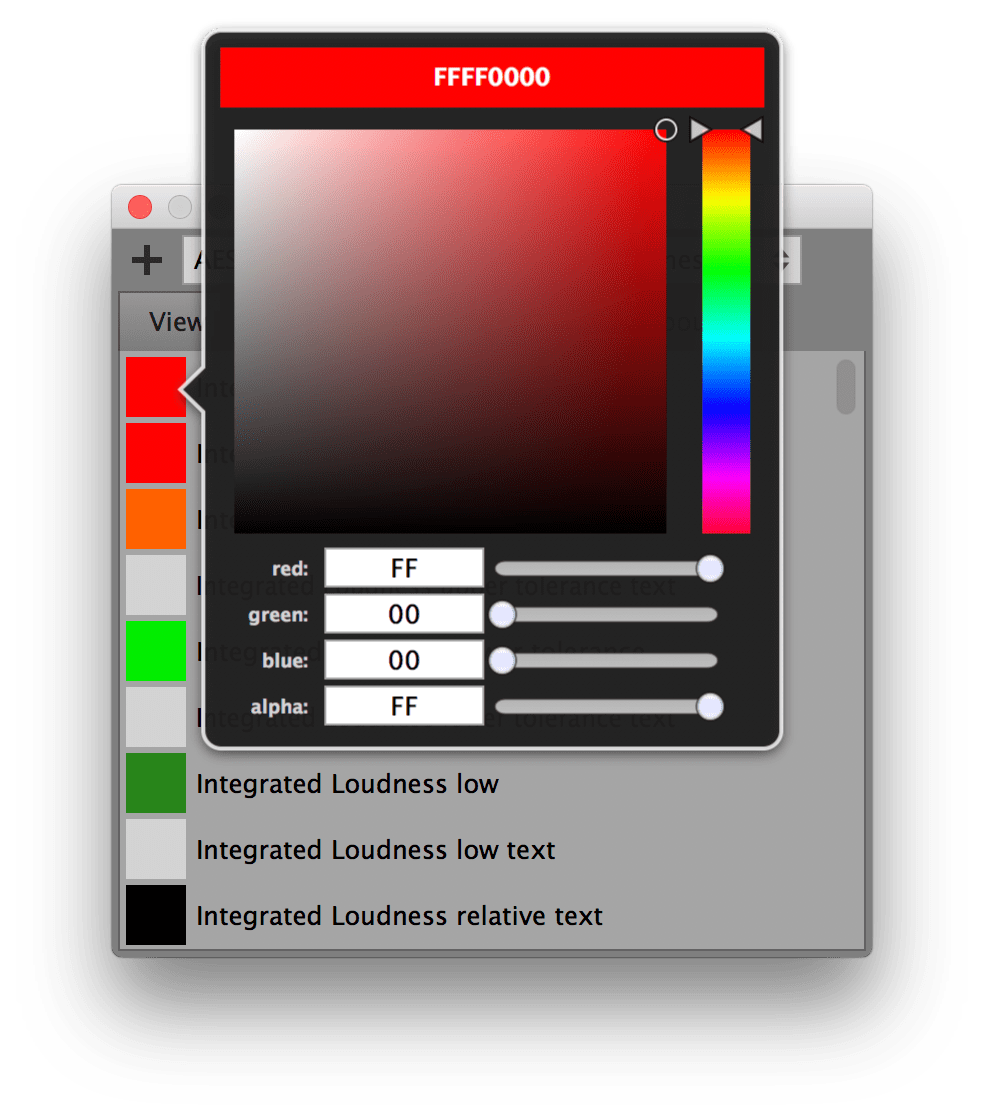
To use the exact same colour on multiple items, a coloured square can be drag and dropped over another one, to copy its colour over.
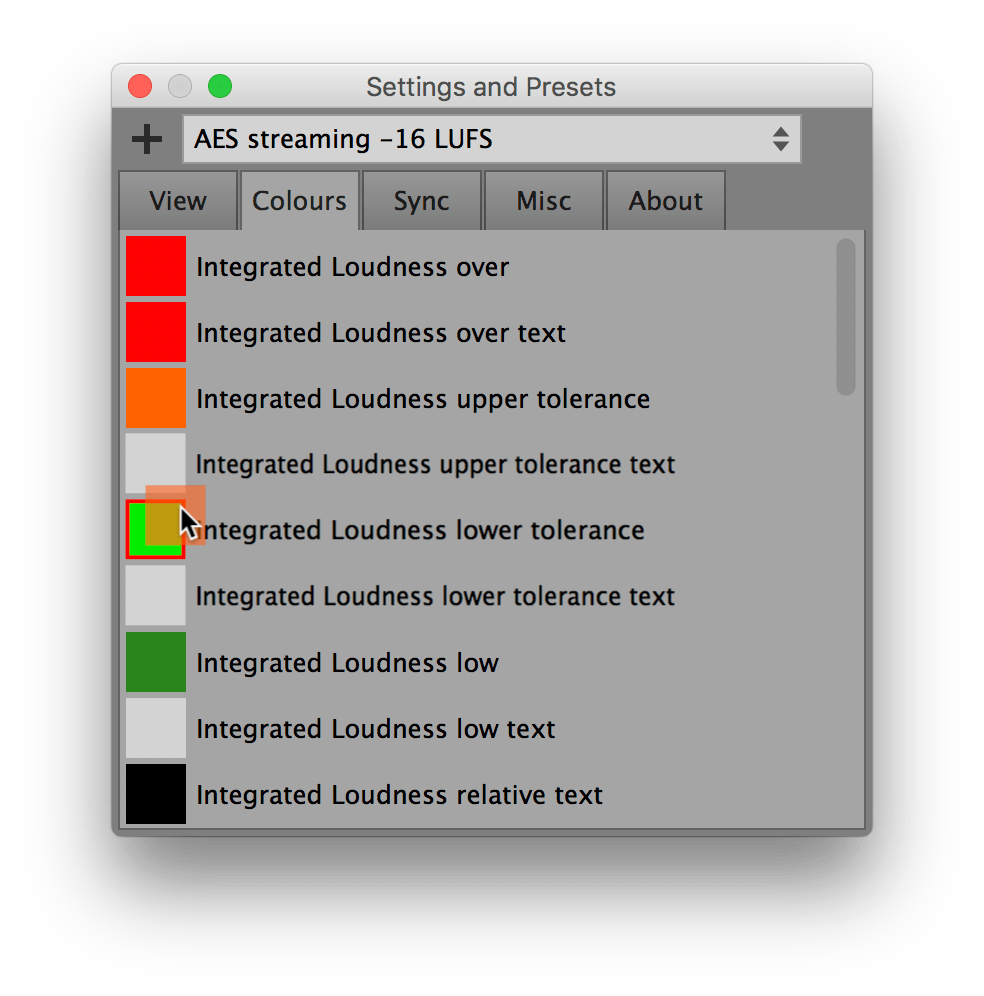
The colour settings section has a padlock icon at the bottom, like the view settings. If engaged, the current colour settings won't be altered if a preset gets loaded.
Hide the help button
If you turn the alpha value of the 'Help button off' colour down to zero, the help button won't be visible anymore if it is toggled off. You can also apply this technique to other elements of the LUFS Meter.
Sync settings
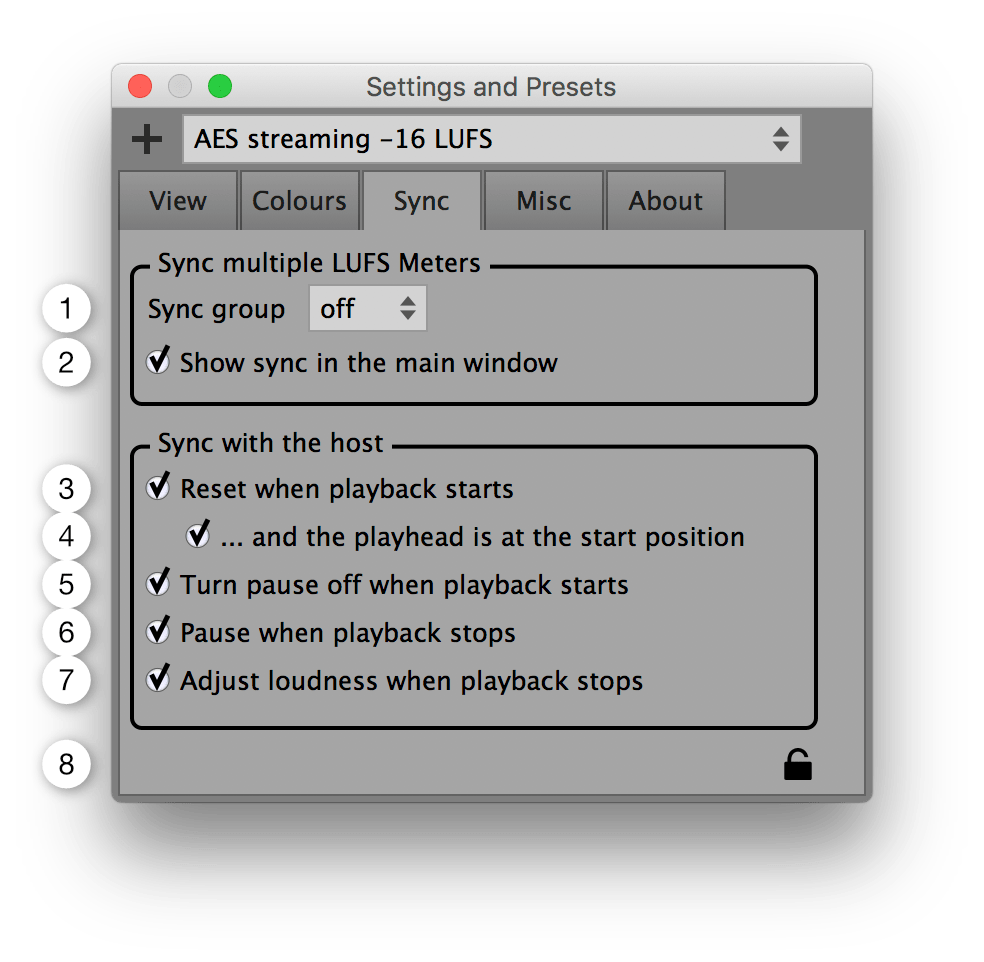
- Assigns a sync group
to this instance of the LUFS Meter.
- Shows or hides the sync group combo box at the bottom right on the main LUFS Meter window. If you use sync a lot, this makes it more accessible.
- Resets the measurement each time the playback is started in the host.
- Only resets the measurement when the playhead of the host is at the start position, i.e. at time 0.
- If pause has been enabled, it will be disabled when the playback starts.
- Pauses the measurement each time the playback is stopped in the host.
- Adjusts the loudness each time the playback is stopped in the host.
- Preset load protection.
If engaged, the sync settings won't be changed when a preset is loaded.
Misc settings

- Enables or disables the true peak calculation.
To measure the true peak, this needs to be enabled before the measurement takes place.
It is recommended to turn it off when not needed because the involved oversampling calculations are quite CPU intense. - When enabled, the oversampling factor for the true peak calculation is set automatically, in accordance with ITU-R BS.1770-4.
- The oversampling factor used for the
true peak calculation.
The desired oversampling factor needs to be set before the measurement takes place. - The maximal possible difference between the
true-peak and the
true peak (= the estimate of
the true-peak).
The maximum true peak deviation can be achieved with a pure 20kHz sine wave with a phase such that the peaks will be aligned exactly between the sampling times of the oversampled signal.
- The currently used sample rate.
If the LUFS Meter operates as a plug-in, the sample rate is set by the host application. - Integrated measurement algorithm.
The document ITU-R BS.1770 specifies how to measure the integrated loudness. It has been changed multiple times over the years.- ITU-R BS.1770 Rev 1 specifies neither overlapping audio blocks nor a gating procedure.
- ITU-R BS.1770 Rev 2 to 4 all specify the exact same way on how to calculate the integrated loudness. Overlapping audio blocks and a gating procedure is used. If in doubt, choose this one.
- When a short measurement is followed by silence, the LRA
value will change. This is in accordance to the definition
of the LRA.
If enabled, the LRA value before a silent section will be displayed during the silence. This is especially useful at the end of a measurement, when you would like to know the exact LRA of your piece but don't want to include the trailing silence in the measurement.
The LRA measurement continues in the background and as soon as the silence is over, the display of the LRA gets updated again. - When clicking the 'adjust to' button, the loudness
will only be adjusted if the measured integrated
loudness is above this threshold.
Thanks to this, muted or very quiet tracks won't be boosted to dangerously high levels. - Preset load protection.
If engaged, the misc settings won't be changed when a preset is loaded.
About section
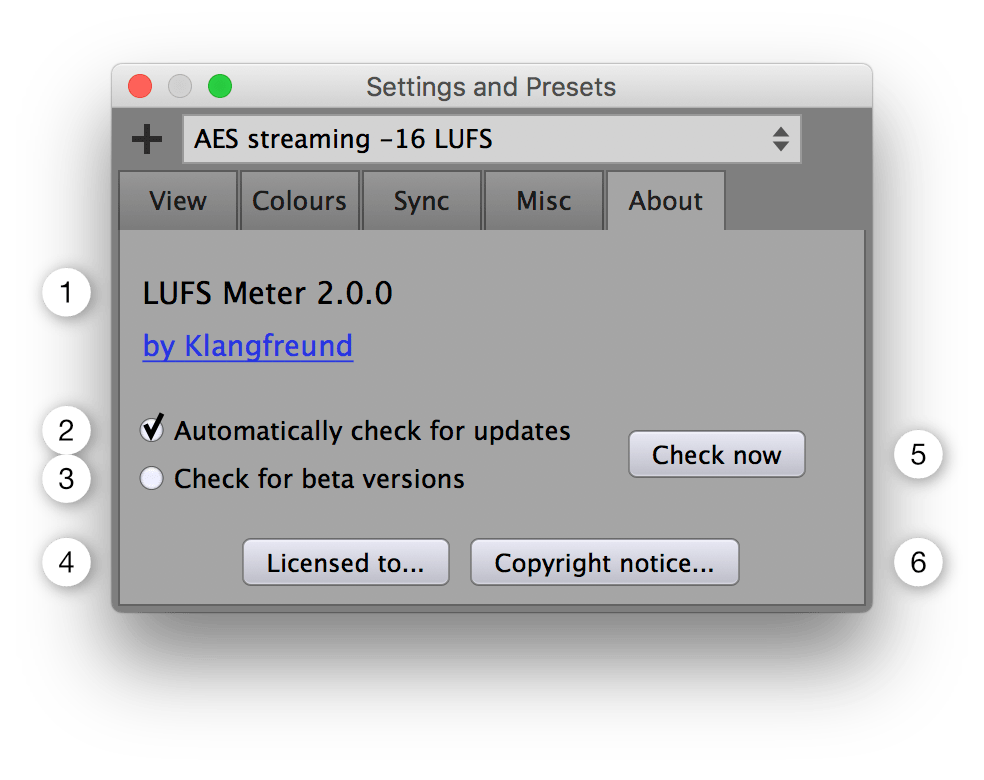
- The current version of the LUFS Meter.
- Automatically check for updates.
The LUFS Meter will check once a week if there is a new version available at klangfreund.com. - Beta versions will also be considered when checking for new LUFS Meter versions.
- Displays the licensing details.
- To manually check if there is a new version available at klangfreund.com.
- Displays the copyright notice.
Appendix
Accuracy of the LUFS Meter
To verify the accuracy of a loudness meter, the ITU and the EBU provide test files. The LUFS Meter passes all these tests. The results are available here.
Files
macOS
The locations of the files for the different plug-in formats are listed below. During the installation you've chosen which ones to install (By default, all are installed).
- /Library/Application Support/Avid/Audio/Plug-Ins/LUFS Meter 2.aaxplugin
- /Library/Audio/Plug-Ins/Components/LUFS Meter 2.component
- /Library/Audio/Plug-Ins/VST/LUFS Meter 2.vst
- /Library/Audio/Plug-Ins/VST3/LUFS Meter 2.vst3
The file containing the unlock information is located at
- /Users/Shared/Music/Audio Music Apps/Klangfreund/LUFS Meter 2/LUFS Meter key.xml
Global settings for the LUFS Meter are written to the file
- /Users/<your user name>/Music/Audio Music Apps/Klangfreund/LUFS Meter 2/LUFS Meter settings.xml
Presets created by the user are stored in the folder
- /Users/<your user name>/Music/Audio Music Apps/Klangfreund/LUFS Meter 2/User Presets/
This folder gets created when the first preset is saved by the user. Each preset is stored in a separate XML file. The startup preset is stored in the startup.xml file. The factory presets are not stored as files, they are contained in the plug-in.
Windows
In contrast to macOS, the 32 and 64 bit VST plug-in formats don't have a well defined file location on Windows. That's why you can choose the location for them in the installer. To help find these locations later, the installer saves a list of all created files to
- C:\Program Files\LUFS Meter 2\InstallationLogFile.log
If you haven't altered the paths during installation, these files were installed to
- C:\Program Files\Common Files\Avid\Audio\Plug-Ins\LUFS Meter 2.aaxplugin
- C:\Program Files\Common Files\VST2\LUFS Meter 2.dll
- C:\Program Files\Common Files\VST3\LUFS Meter 2.vst3
- C:\Program Files (x86)\Common Files\Avid\Audio\Plug-Ins\LUFS Meter 2.aaxplugin
- C:\Program Files (x86)\Common Files\VST2\LUFS Meter 2 (32 Bit).dll
- C:\Program Files (x86)\Common Files\VST3\LUFS Meter 2 (32 Bit).vst3
Under Windows XP, the file containing the unlock information is located at
- C:\Documents and Settings\All Users\Application Data\Klangfreund\LUFS Meter 2\LUFS Meter key.xml
Under newer versions of Windows, the file containing the unlock information is located at
- C:\ProgramData\Klangfreund\LUFS Meter 2\LUFS Meter key.xml
Global settings for the LUFS Meter are written to the file
- C:\Users\<your user name>\AppData\Roaming\Klangfreund\LUFS Meter 2\LUFS Meter settings.xml
Presets created by the user are stored in the folder
- C:\Users\<your user name>\AppData\Roaming\Klangfreund\LUFS Meter 2\User Presets\
This folder gets created when the first preset is saved by the user. Each preset is stored in a separate XML file. The startup preset is stored in the startup.xml file. The factory presets are not stored as files, they are contained in the plug-in.
Linux
The README file provided by Klangfreund suggests to put the plug-in files to
- ~/.vst/LUFSMeter2.so
- ~/.vst/LUFSMeter2_32bit.so
But you might have placed them somewhere else.
The file containing the unlock information is located at
- ~/.config/Klangfreund/LUFS Meter 2/LUFS Meter key.xml
Global settings for the LUFS Meter are written to
- ~/.config/Klangfreund/LUFS Meter 2/LUFS Meter settings.xml
Presets created by the user are stored in the folder
- ~/.config/Klangfreund/LUFS Meter 2/User Presets/
This folder gets created when the first preset is saved by the user. Each preset is stored in a separate XML file. The startup preset is stored in the startup.xml file. The factory presets are not stored as files, they are contained in the plug-in.
Troubleshooting
Hardware changes
If you completely reinstall the whole operating system or if you entirely switch to a new computer, the LUFS Meter needs to be unlocked again. In some cases it is also needed after a change or upgrade of the hardware of your computer.
After a certain amount of unlocks (depending on the number of licenses you own), you will run out of unlock slots. To reclaim unlock slots, deactivate old unlock slots you no longer need in your personal account.
Restore write access to unlock the LUFS Meter
When unlocking the LUFS Meter, it writes the unlocking information to a key file on disk, such that it stays unlocked in the future. If the LUFS Meter detects that this key file can't be written it displays a warning.
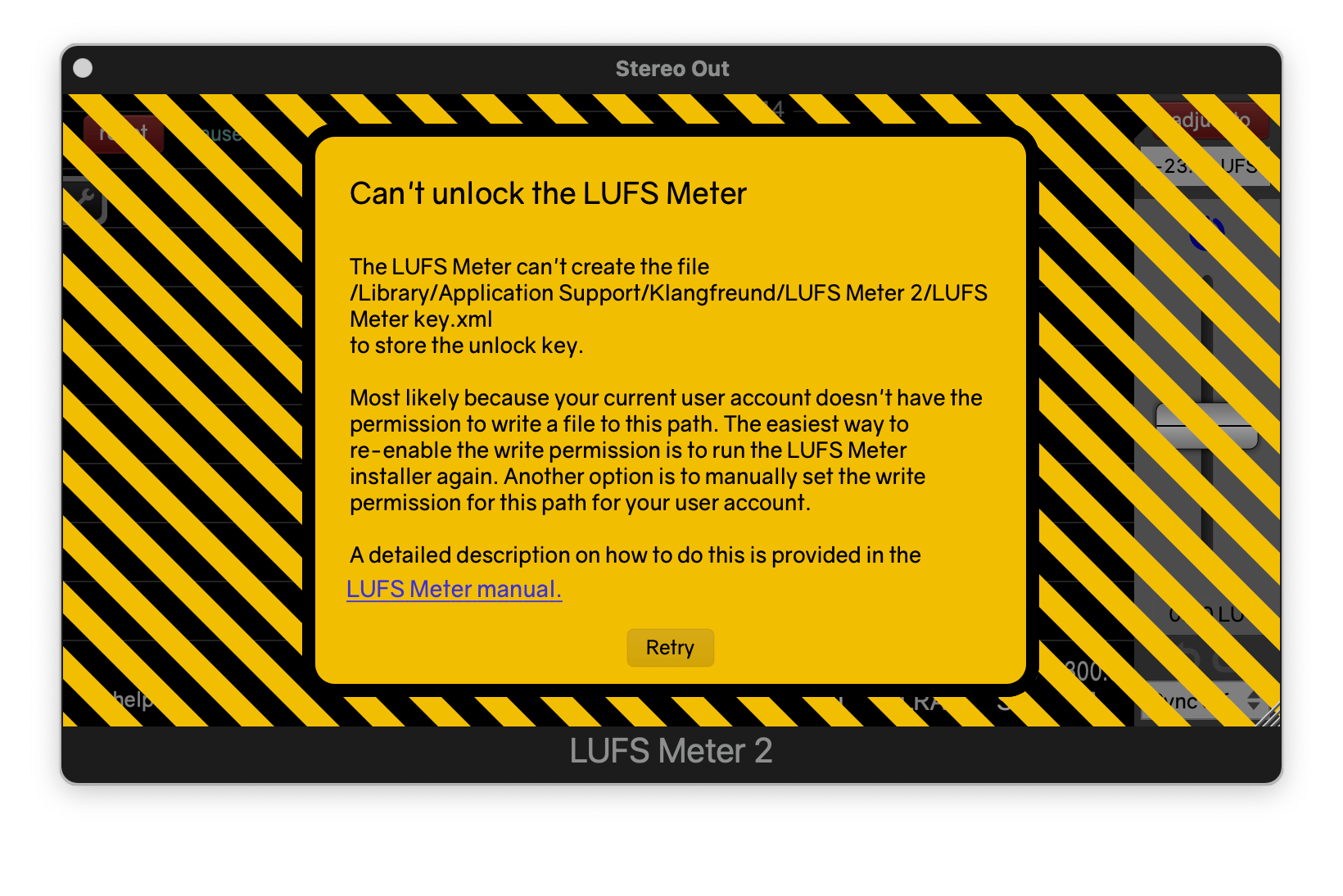
With your current user account you most likely don't have write access to the specific path anymore. You need to restore the write access.
Restore write access under macOS
To restore write access for the key file, such that the LUFS Meter can be unlocked, open the Finder. Navigate to the deepest folder in the path
- /Users/Shared/Music/Audio Music Apps/Klangfreund/LUFS Meter 2/
that exists on your system. For example, if /Users/Shared/Music/ is available but 'Audio Music Apps' isn't, navigate to /Users/Shared/ and select the 'Music' folder. Press Command-i and open the 'Sharing & Permissions' section at the bottom. To be able to change the permissions, the padlock icon at the bottom right must display an open padlock. If it doesn't, click it and enter your password. If your user name is listed, change its privilege from 'Read only' to 'Read & Write'. If it isn't listed, click the '+' at the bottom left, choose your user name and set the privilege to 'Read & Write'.
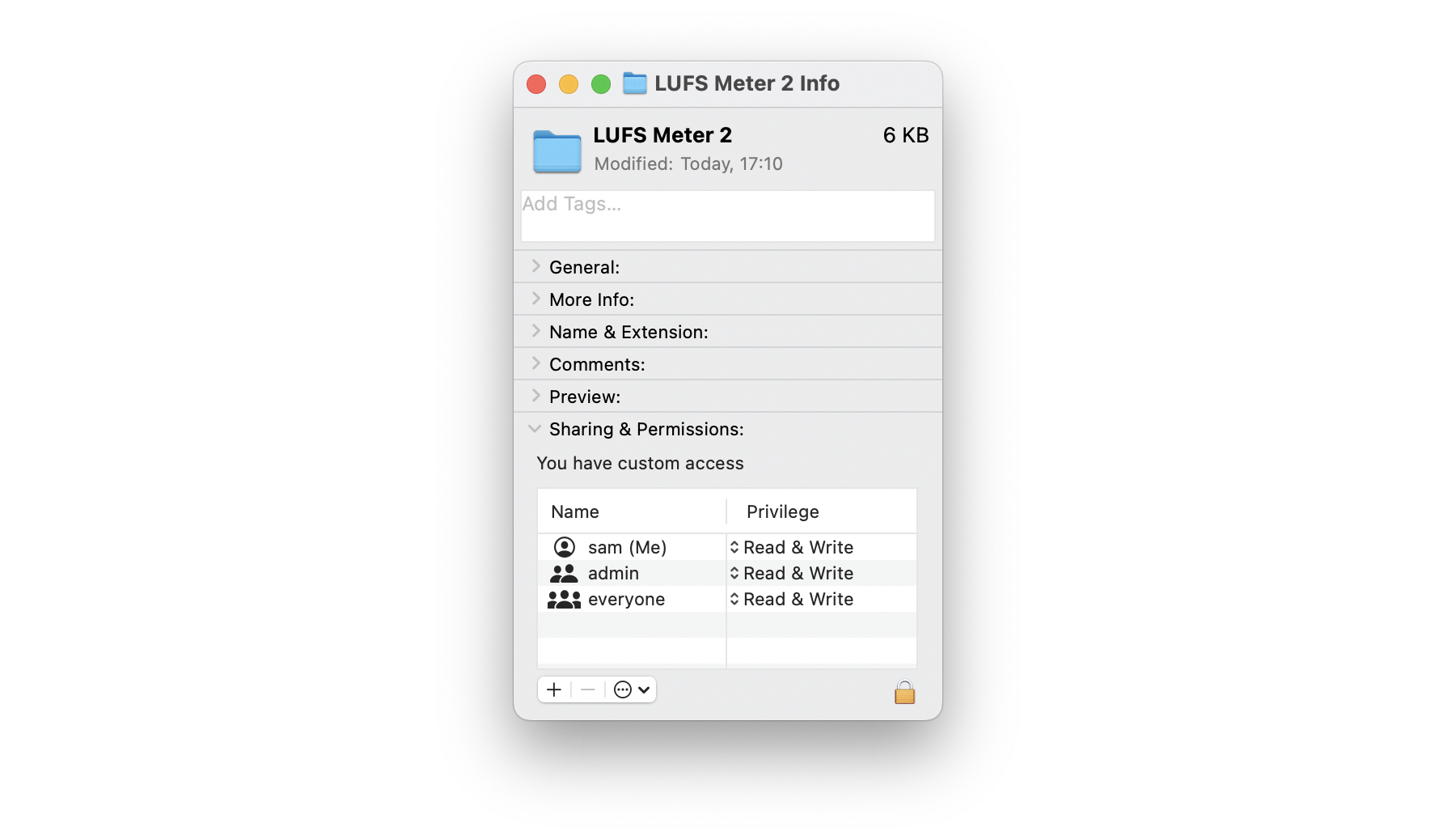
Switch back to the LUFS Meter and hit the 'Retry' button. Or restart the LUFS Meter. This creates the folder structure as needed.
Restore write access under Windows
To restore write access for the key file, such that the LUFS Meter can be unlocked, open the Explorer (Windows Key + E). Navigate to the deepest folder in the path
- C:\ProgramData\Klangfreund\LUFS Meter 2\
that exists on your system (If you are using Windows XP, the path is different). For example, if 'C:\ProgramData\' is available but 'Klangfreund' isn't, navigate to 'C:\'. Ensure that the Explorer displays hidden files and folders, such that 'ProgramData' is visible. Select the 'ProgramData' folder and press Alt-Enter to open the properties. Switch to the Security tab and click the 'Edit...' button located in the middle right to open the Permissions window. Select 'Administrators' in the top list and enable the Allow-box for 'Write' in the bottom list. Repeat this for the 'Users' entry.
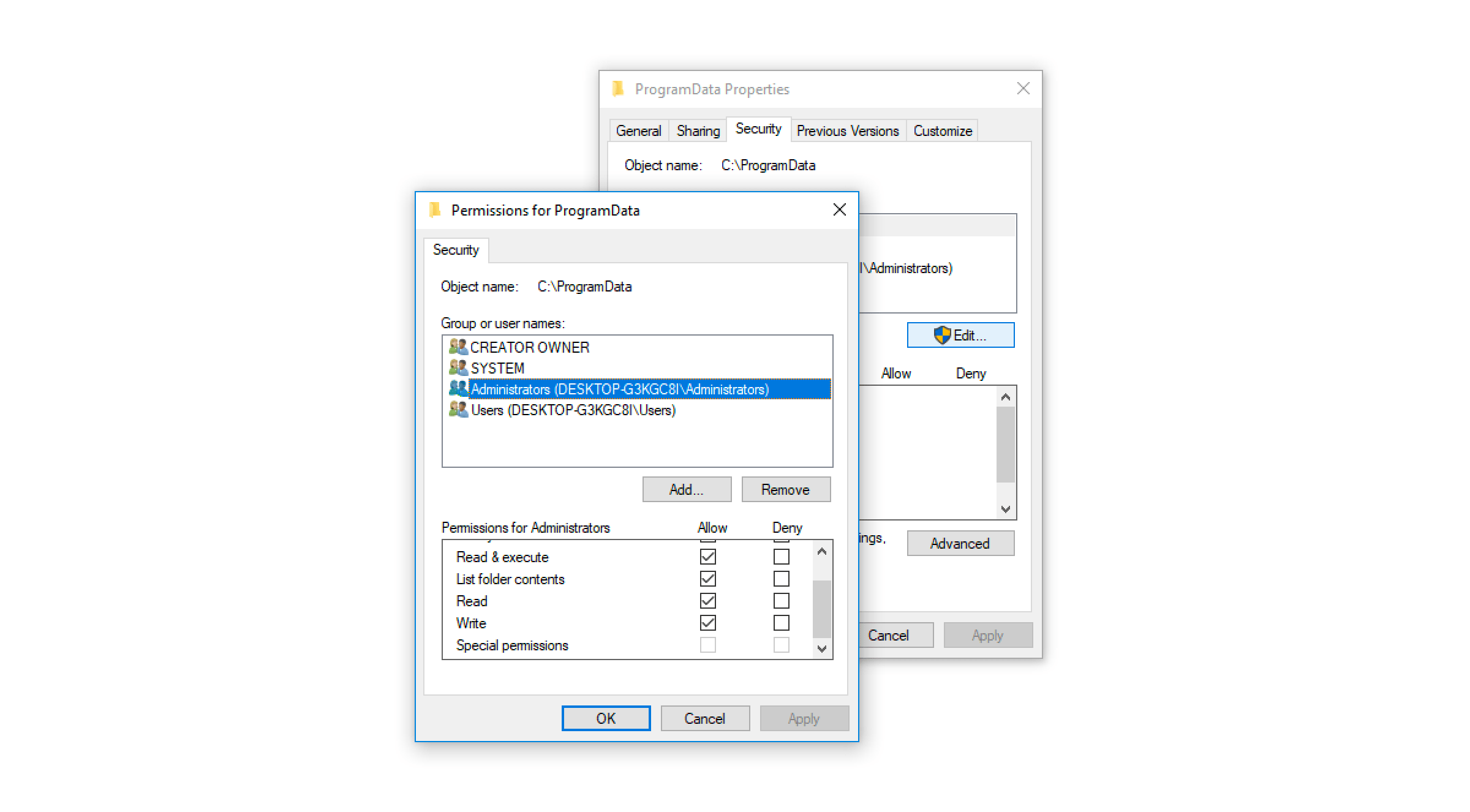
Switch back to the LUFS Meter and hit the 'Retry' button. Or restart the LUFS Meter. This creates the folder structure as needed.
Alternatively you could start your DAW by right clicking on it and selecting 'run as administrator'. This way the LUFS Meter should be able to create the key file and store the unlock information to it. Once created, the LUFS Meter only needs read access for the key file - 'run as administrator' won't be needed any more.
Restore write access under Linux
To restore write access for the key file, such that the LUFS Meter can be unlocked, open a terminal and navigate to the deepest directory available in the path
- ~/.config/Klangfreund/LUFS Meter 2/
For example '~/.config/' might be available, but '~/.config/Klangfreund' isn't. In this case use for example 'chmod 755 ~/.config' to restore write permission.
Switch back to the LUFS Meter and hit the 'Retry' button. Or restart the LUFS Meter. This creates the folder structure as needed.
Pro Tools AAE error -7106
After upgrading the LUFS Meter it can happen that you can't open the stereo LUFS Meter in Pro Tools anymore. Instead of the user interface, a pop up window appers showing 'AAE error -7106'.
This procedure should fix the issue:
- Close Pro Tools.
- Remove the AAX version of the LUFS Meter: On Windows, run the uninstaller. On OS X, manually remove the aaxplugin file.
- Open Pro Tools, create a new empty session, add an empty stereo track and verify in one of its insert slots that there is no LUFS Meter available in the AAX 'Other' category. Close Pro Tools.
- Re-install the LUFS Meter.
Revalidate all Audio Units
If a plug-in doesn't appear in Logic or GarageBand it might help to clear the Audio Unit cache. This will enfore revalidation of all Audio Unit plug-ins which might take a few minutes, depending on the number of plug-ins you have installed.
- Close all audio unit hosts (like Logic and GarageBand).
- In the Finder, press Command-Shift-G.
- Enter "~/Library/Caches/" and press return.
- Move the file com.apple.audiounits.cache and the folder AudioUnitCache to the Desktop.
- Relaunch Logic or GarageBand, all Audio Unit plug-ins will be revalidated.
- Delete com.apple.audiounits.cache and AudioUnitCache from your desktop.
Final Cut Pro X: Audio skimming
Final Cut Pro X together with audio plug-ins is more sturdy if audio skimming is turned off. This also holds true for the LUFS Meter.
Final Cut Pro X: Failing AU validation
If Final Cut Pro X shows a dialog on launch that says that the LUFS Meter hasn't passed the AU validation and is therefore disabled, the AU validation process can be retriggered to solve this issue. Be aware that this will scan all your audio unit plug-ins again which might take a few minutes, depending on the number of audio plug-ins you have installed. To proceed:
- Open the preferences in Final Cut Pro X.
- Go to General an click the 'Audio Units: Validate on Next Launch' button.
- Relaunch Final Cut Pro X.
If you have an older version of Final Cut Pro X without this option available
- Quit Final Cut Pro X.
- Move the file /Users/sam/Library/Preferences/com.apple.audio.InfoHelper.plist to the Desktop.
- Relaunch Final Cut Pro X.
- Delete the file com.apple.audio.InfoHelper.plist from the Desktop.
as described in more detail here.
Audacity: VST recommended over AU
If you use the LUFS Meter in Audacity under macOS, it is recommended to exclusively use the VST version of the LUFS Meter. The VST implementation of Audacity works better than its audio unit implementation.
Uninstall
macOS
OS X does not provide an uninstall mechanism. You have to manually delete the LUFS Meter files.
Windows
Run the uninstaller. Either directly from
- C:\Program Files\LUFS Meter 2\unins000.exe
or select the 'LUFS Meter 2' in the Windows Settings -> Add or remove programs.
Acknowledgements
Samuel from Klangfreund is deeply grateful for all the feedback and support received by many wonderful users!
Honorable mention of outstanding beta testers:
Dennis Wilkins
and Thomas Riegger.
Copyright notice
The End User License Agreement (EULA) describes your rights and the conditions upon which you may use the LUFS Meter and all related documents provided by Klangfreund.
AAX and Pro Tools are trademarks of Avid Technology.
Apple, Audio Units, Final Cut Pro X, Finder, GarageBand, Logic
Pro X, Mac and macOS are trademarks of Apple Inc.
ASIO and VST are trademarks of Steinberg Media Technologies
GmbH.
Reaper is a trademark of Cockos Inc.
Windows is a trademark of Microsoft Corporation.
PDF manual
This manual is also available as a PDF manual